- Question Papers
- Scholarships

Marketing Research Question Bank
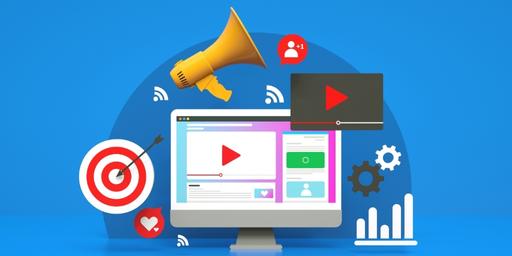
Given below is the Marketing Research Question Bank useful for MBA, MMS, BBA, PGDM and other management students. This is also useful for exam preparation of subjects like Contemporary Marketing Research. Hope this set of MR important questions will help you score better in the university examination. This question bank is useful for various top universities like Pune University, Mumbai University etc.
Given below is the Question Bank of Marketing Research (MR) –
Long Questions (5 or 10 Marks)
- What is a Marketing Information system (MIS)? Discuss its components.
- Discuss briefly the meaning of marketing research. Explain its significance in Modern times.
- Define Marketing Research. Discuss the applications of Marketing Research in various decisions in marketing management.
- Discuss in detail ethical issues in Marketing Research.
- Briefly describe steps involved in Marketing Research.
- What is qualitative research? Discuss different methods of conducting qualitative research.
- Discuss the contents of Marketing Research Proposal. Give a research proposal for a study required by a company which intends to launch a new brand of health drink.
- What is Research Design? Explain types of Research Design with suitable applications.
- Discuss different types of sampling methods.
- Discuss in detail various methods of probability and nonprobability sampling.
- Design a questionnaire to study online buying behaviour of consumers for electronic goods using appropriate attitudinal scale
- Explain the term scaling. Elaborate applications of Likert and Semantic Differential Scales.
- What is Multi-dimensional scaling? Discuss its use in marketing research with suitable examples.
- What sampling design would you select for a study to find out the household expenditure on home care products by various income groups? Give details of sampling design & method with proper justification. Make assumptions as required.
- What is conjoint analysis? Discuss applications of conjoint analysis.
- What is Factor analysis? Discuss the applications of factor analysis.
- Discuss the concept of cluster analysis and its importance in marketing research. Explain salient features of cluster analysis with suitable illustrations. Explain the procedure of ‘cluster Analysis’ and ‘clustering methods’.
- Explain the application of cluster analysis in Marketing. Interpret the following perceptual map. generated from a hypothetical example of No. of store visits & expenditure in visits per year for 15 individuals. (Ato O)What is Discriminant Analysis? Discuss its objectives and applications in Marketing Research.
- Differentiate between univariate and multivariate techniques. Which category of techniques is best suited for consumer research and why?
- Discuss ‘Balanced vs Unbalanced’ scale and ‘Forced vs Unforced’ scale.
- What is the ‘chi square’ test? Explain its applications in Marketing Research.
- What is test marketing? What are the objectives & applications of Test Marketing? Suggest a Test Marketing Procedure for launch of new health supplement product for working women.
- Discuss various applications of Consumer Panels in Marketing Research.
- Explain content and construct validity in detail. (Subpoint of quantitative research)
- Discuss Reliability and Validity Testing of Measurement Scales used in Marketing Research. (Subpoint of quantitative research)
- What is a multi-item scale? Discuss different approaches to assess the reliability and validity of the scale.
- Explain the importance of Experimental Designs in Marketing Research. Explain Before-After and Before-After with Control Group Design.
- Discuss ‘Experience Survey’ and application of ‘Fours Groups’ in marketing research.
- What is experimentation in Marketing Research? Mention the type of experimental design in the following situation. i) Sales revenue is observed after the training of sales persons at a readymade garment shop. ii) Attitude of customers is measured before & after the new advertisement of a product.
Short Questions (2 or 5 marks)
- Media Audience Tracking Studies.
- Retail Shop Audit.
- Advertising copy research.
- Readership Surveys
- Channel behaviour
- Opinion polls
- Syndicated Research
- Coding & Tabulation
- Sales Forecasting
- Problems of conducting research in India
- Statistical designs’ and ‘Randomised Block’ designs.
- ANOVA, its applications, and methods in testing the hypotheses
This is all about question bank of Marketing research for management students.
Share with friends
- (855) 776-7763
All Products
BIGContacts CRM
Survey Maker
ProProfs.com
- Get Started Free
Want insights that improve experience & conversions?
Capture customer feedback to improve customer experience & grow conversions.
100+ Market Research Questions to Ask Your Customers

Babu Jayaram
Head of Customer Success - ProProfs
Review Board Member
Babu Jayaram brings over 20 years of experience in sales and customer service to his role on the Qualaroo Advisory Board. With a profound understanding of sales and conversion strategies, ... Read more
Babu Jayaram brings over 20 years of experience in sales and customer service to his role on the Qualaroo Advisory Board. With a profound understanding of sales and conversion strategies, Babu is committed to delivering exceptional results and fostering robust customer relationships. His expertise extends beyond mere management, including adept handling of support tickets, overseeing internal and customer-facing knowledge bases, and training support teams across diverse industries to ensure exceptional service delivery. Read less
Product Manager at Qualaroo
Dwayne is a seasoned Product Manager 10+ years of experience. His articles offer a fresh perspective on the dynamic and ever-evolving world of customer-centric strategies.

Asking the right market research questions can help you understand your target customers and map their behavior and preferences.
But what does it actually mean?
Let’s look at a sample from a market research survey report for mapping brand awareness:
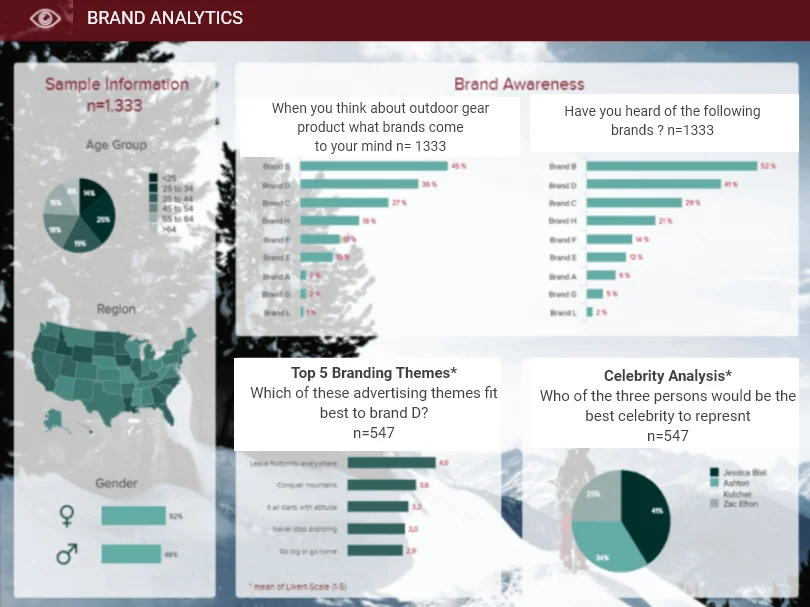
From this simple Q&A report, you can:
- Visualize the proportions of demographic segments among your audience.
- Measure how your brand is performing in comparison to others.
- Pick the top preferred brand among the customers, explore what makes it stand out, and apply the same techniques to your brand.
- See how your target market perceives brand advertisements and promotional efforts.
Now imagine if this type of data set is available for different aspects of your business – product development, marketing campaigns, optimization plans, and more.
That’s what market research does for you.
With the evolution of customer interaction points and constantly changing market trends, more and more businesses are fueling efforts to do in-depth market research, as evidenced by the steady increase in the revenue of the market research industry worldwide.
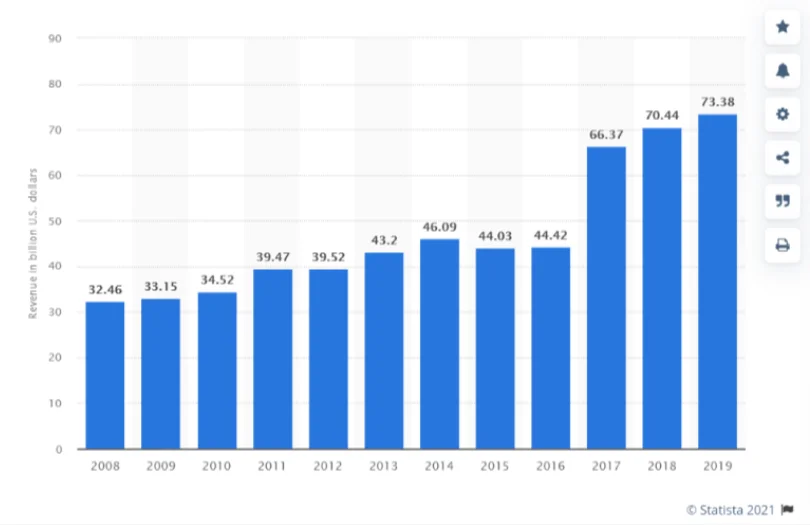
Market research can help you develop essential business strategies and maintain a competitive advantage over other brands to increase conversions and customer base.
And it all starts with asking the right questions to the right audience.
That’s why we have created this collection of 100+ market research questions to ask your target market. Each question aims to uncover a specific attribute about your customers. You can use a combination of these customer research survey questions, interviews, and othe marketing questionnaires for customers.
We have also added key tips to help you write your own effective market analysis questions if the needed.
100+ Great Market Research Questions to Ask Your Customers
The main challenge while designing and conducting research is – “What questions should I ask in my customer research survey?
That’s why we have a carefully curated list of market research questions to help you get started.
To Explore New Product Opportunities

- What was your first reaction to the product?
- Would you purchase this product if it were available today?
- What feature would you like to see on the website/product?
- Which feature do you think will help improve the product experience for you?
- Of these four options, what’s the next thing you think we should build?
- What’s the one feature we can add that would make our product indispensable for you?
- Would implementing [this feature] increase the usability of the [product name]?
- Please let us know how we can further improve this feature.
- What problem would you like to solve with our product?
To Collect Feedback on Existing Products
- Have you heard of [product name or category] before?
- How would you feel if [product name] was no longer available?
- How disappointed would you be if you could no longer use [Product/feature name?]
- How often do you use [product name]?
- How long have you been using [product name] for?
- When was the last time you used [product name]?
- Please rate the following product features according to their importance to you.
- According to you, In which area is this product/service lacking the most? Specify below.
- How does the product run after the update?
- Rate our product based on the following aspects:
- Have you faced any problems with the product? Specify below.
- What feature did you expect but not find?
- How are you planning to use [product or service]?
- How satisfied are you with the product?
To Segment the Target Market
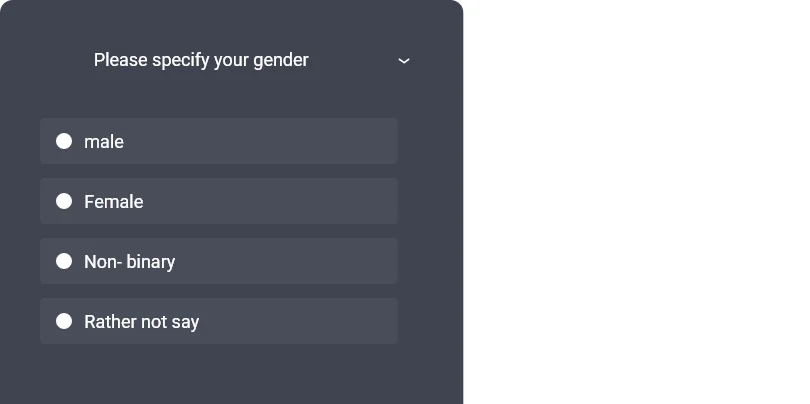
Please specify your age.
- Please specify your gender.
- Select your highest level of education.
- What is your current occupation?
- What is your monthly household income?
- What is your current marital status?

- What is the name of your company?
- Where is your company’s headquarters located?
- Please specify the number of employees that work in your company.
- What is your job title?
- In which location do you work?
- Which activity do you prefer in your free time?
- Which other physical activities do you take part in?
- Where is your dream holiday destination?
- Please rate the following as per their priority in your life – Family, work, and social life?
- Are you happy with your current work-life balance?
- Do you describe yourself as an optimist or a pessimist?
- How often do you give to charity?
- How do you travel to work?
- How do you do your Holiday shopping?
To Conduct a Competition Analysis

- Which product/service would you consider as an alternative to ours?
- Rate our competitor based on the following:
- Have you seen any website/product/app with a similar feature?
- How would you compare our products to our competitors?
- Why did you choose to use our [product] over other options?
- Compared to our competitors, is our product quality better, worse, or about the same?
- Which other options did you consider before choosing [product name]?
- Please list the top three things that persuaded you to use us rather than a competitor.
- According to you, which brand best fits each of the following traits.
To Gauge Brand Awareness
- [Your brand name] Have you heard of the brand before?
- How do you feel about this brand?
- How did you hear about us?
- Describe [brand name] in one sentence.
- If yes, please tell us what you like the most about [your brand name]?
- If no, please specify the reason.
- How likely are you to purchase a product from this company again?
- If yes, where have you seen or heard about our brand recently? (Select all that apply)
- Do you currently use the product of this brand?
- Have you purchased from this brand before?
- Of all the brands offering similar products, which do you feel is the best brand?
- Please specify what makes it the best brand for you in the category.
- Which of the following products have you tried? (Select all that apply)
- On a scale of 1 to 10, how likely would you recommend this brand to a friend or colleague?
To Map Customers’ Preferences
- Have you ever boycotted a brand? If so, which brand and why?
- What influences your purchase decision more – price or quality of the item?
- How many hours do you spend on social media like Facebook, Instagram, etc.?
- How do you do your monthly grocery shopping – online or through outlets?
- How do you search for the products you want to buy?
- Rate the factors that affect your buying decision for [product].
- What persuaded you to purchase from us?
- How likely are you to purchase a product from us again?
- Please rate the following aspects of our product based on their importance to you.
- What is the most important value our product offers to you?
- Which of the following features do you use least?
- How well does the product meet your needs?
To Map Customers’ Reservations
- Is there anything preventing you from purchasing at this point?
- What’s preventing you from starting a trial?
- Do you have any questions before you complete your purchase?
- What is the main reason you’re canceling your account?
- What are your main reasons for leaving?
- What was your biggest fear or concern about purchasing from us?
- What is the problem that the product/service helped to solve for you?
- What problems did you encounter while using our [product]?
- How easy did we make it to solve your problem?
- What is your greatest concern about [product]?
- Have you started using other similar products? If yes, what made you choose that product?
To Perform Pricing Analysis
- Would you purchase the product at [price]
- According to you, what should be the ideal price of the [product name]?
- Is our product pricing clear?
- According to you, what is the ideal price range for the product?
To Collect Feedback on Website Copy
- Please rate the website based on the following aspects:
- How well does the website meet your needs?
- Was the information easy to find?
- Was the information clearly presented?
- What other information should we provide on our website?
- How can we make the site easier to use?
- What could we do to make this site more useful?
- Is there anything on this site that doesn’t work the way you expected it to?
- How easy was it to find the information you were looking for?
- Have feedback or an idea? Leave it here!
- Help us make the product better. Please leave your feedback.
To Assess Website/Product Usability
- Are you satisfied with the website layout?
- What features do you think are missing on our website?
- What features do you not like on our website?
- Was our website navigation simple and user-friendly?
- How much time did it take to find what you were looking for on our website?
- Was it easy to find the products you are looking for?
- Was the payment process convenient?
To Uncover Market Trends and Industry Insights
- Did you purchase our product out of peer influence or individual preference?
- How do you form your opinion about our product?
- Do you follow trends of the product, or do you prefer to go with what you know?
- Do discounts or incentives impact your decision-making process?
Market Research Survey Templates
One of the easiest ways to conduct market research is to use survey templates. They can help you save time and effort in creating your own market research surveys.
There are many types of market research survey templates available, depending on your objectives and target audience. Some of the most popular ones are:
- Demographic Templates: These templates help you segment your customers based on their location. It can help you tailor your marketing strategies and offers to different customer groups.

- Consumer Behavior Templates: These templates help you keep your pulse on your target market.
Industry Insights Templates: These templates help you get detailed information about your target industry and business.

Breakdown of Different Market Research Questions
The answer choices in a market research survey question can significantly impact the quality and reliability of the response data you collect from the audience.
Some answer types help categorize the audience, while others measure their satisfaction or agreement.
So, before listing the customer research survey questions to ask your target audience, let’s understand their types:
Multiple Choice
A multiple-choice question type lets users select more than one answer from the given options. These questions are great for collecting multiple data sets using the same question and gauging people’s preferences, opinions, and suggestions .
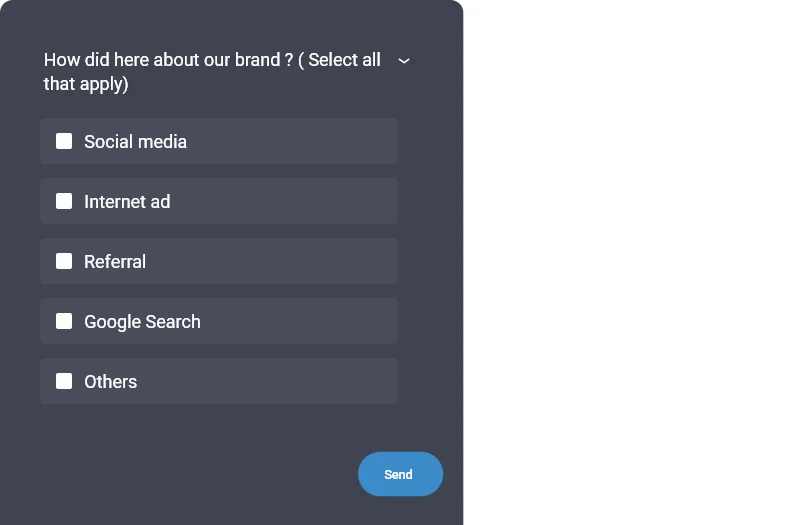
Single Choice
In a single-choice question, the respondent can select only one answer from the given options. This question type is great for:
- Segregating the users.
- Prioritizing product updates based on user consensus.
- Disqualifying irrelevant respondents by placing the question at the start of your customer research survey.
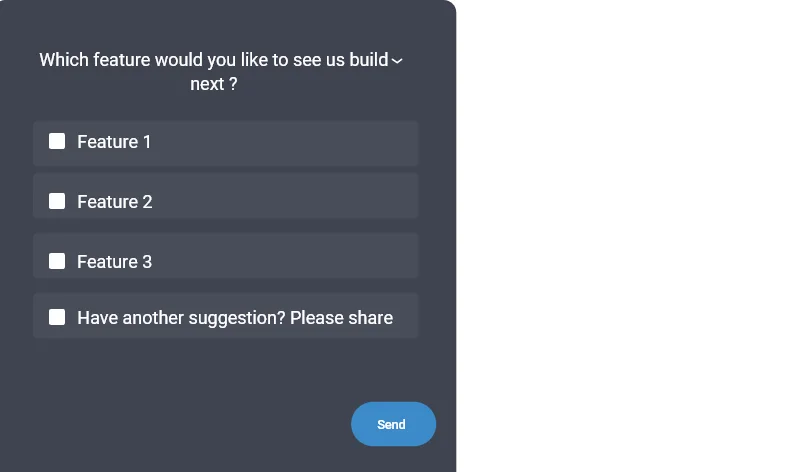
Matrix Match
A matrix matching grid can combine multiple market research questions into one to make the survey shorter . There is only one condition – the individual questions should have the same response anchors as shown in the image below:
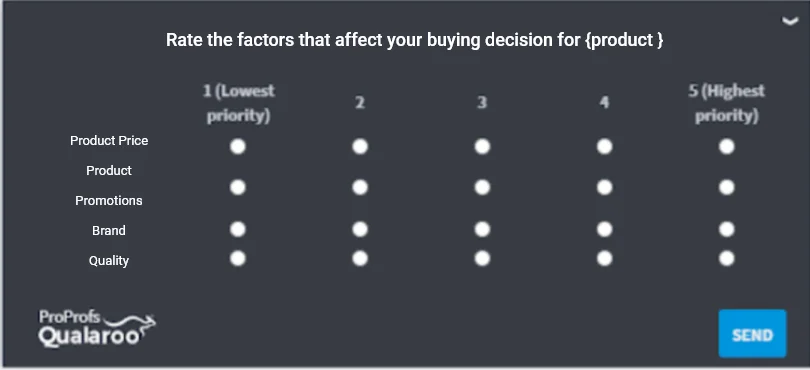
The questions are arranged in rows while the answer options occupy the grid columns.
Ranking Question
A ranking question can help map customers’ preferences and set priorities for product development . This question type asks the respondent to arrange the given options in their decreasing/increasing preference.
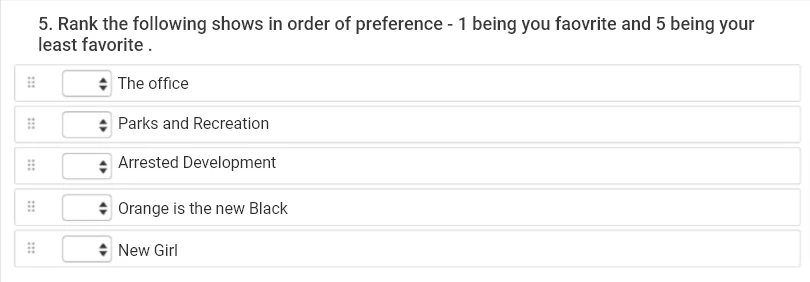
Dichotomous
A dichotomous question poses a simple yes or no scenario to the respondent. These question types can help disqualify irrelevant people from the survey and categorize the users into two groups .
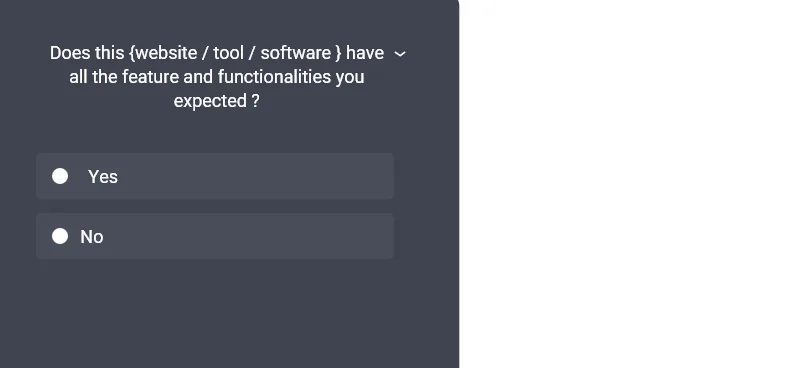
Likert Scale
Likert scale market research questions can help you measure the extent of respondents’ agreement/disagreement with the given statement . The answer options are arranged from positive to negative sentiments or vice-versa, with the neutral option in the middle.
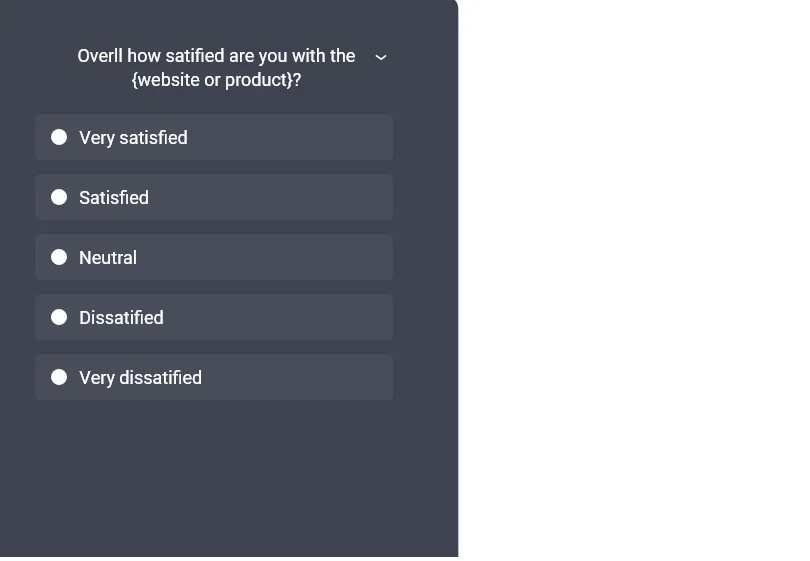
There are two types of Likert scales: 5-point and 7-point .
Open-ended market questions let you explore the respondents’ minds without adding any restrictions to the answer . This question type is followed by a blank space for the respondent to add a free-text response.

You can add an open-ended question as a follow-up after the first question to explore the reasons for the customer’s previous answer. It also lets you collect more in-depth information about their issues, pain points, and delights.
Tools like Qualaroo offer tons of different question types for your surveys. Just pick the question and match its answer option type from the drop-down. To make it more effective, you can add branching to the survey.
How to Write Your Marketing Research Questions
It’s imperative to have a dedicated repository of market research questions for your surveys. But nothing’s better than crafting your questions.
For this, you need to sit with your team and discuss what information you require from the customers. It lets you analyze and document how much data you already have in your system, which can help set the market research scope.
We have listed some questions you need to ask yourself before asking market research questions to your potential customers or target market:
Audience Segmentation Questions
Audience segmentation questions help to size up your target market and provide a granular view of the audience . Not all customers are equal, and audience segmentation makes it possible to focus on each group individually to address their issues, fears, and expectations.
Here’s what you need to know before you start writing customer research survey questions to understand your audience:
- Do we understand the demographics of the new market we are trying to target? (Age, location, ethnicity, education, company, annual income, etc.)
- What are the locations that drive the most customers to our business? How are these locations different from others?
- What are the interests, preferences, and fears of people from our new target market? Have we addressed these situations for our current customer base?
- What are the psychographics attributes of the current customers and potential market? Are we targeting these in our campaigns?
- What are the most popular engagement channels for our customers? Which channels drive the most traffic to our website?
- Do we have enough data to perform value segmentation to separate high-value customers from low-value customers?
- How often do these high-value customers make a purchase?
Product-Based Market Research Questions
Product-based market research questions can produce precious insights to channel into your product development and optimization strategies . You can see how changing technology affects customers’ behavior, what new features they want to see in your product, and how they perceive your products and services over the competition.
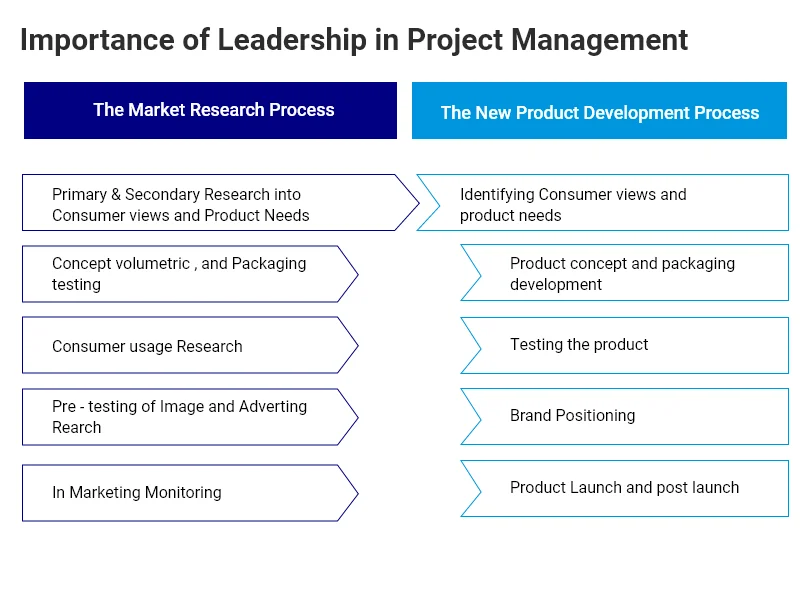
Start by gathering information about the following:
- How does our product compare to the competition based on the features?
- What products do our competitors offer?
- What new features do customers want to see in our products? Do we have a product roadmap to deliver these updates?
- What unique solutions do our products offer? What is the value proposition that reflects this offering?
- Does our product incorporate the latest technological advancements?
- What channels do we use to collect product feedback from our users?
- What are customers’ preferences while choosing our products over competitors?
Pricing Market Research Questions
Pricing analysis can help you make your product more affordable to different customer segments while maintaining the desired gross margin. It also lets you restructure the pricing tiers to provide features depending on the customers’ requirements and company size .
Watch: (1/5) Supercharge Your Revenue With Data-Driven Pricing
Your sales and marketing team can help you hone in on the market research questions to ask your customers for running pricing analysis:
- Do the customers ever complain about the difficulty in finding the pricing information?
- What is the pricing structure of our competitors for the same products? What features do they include for a specific price?
- How do customers find our pricing when compared to the competitors?
- Do our products provide value for money to the customers? Does the sales pitch reflect this point?
- Can we restructure the pricing, and how will it affect the revenue?
- Are there any customer segments that have high-value potential but find the current pricing unaffordable? What are the plans for such customers?
- Are we in a situation to offer a basic free plan to encourage customers to try our product before upgrading?
- What promotions can we run to attract more customers?
- Should we target customers based on income, company size, or type of solution to set our product prices?
Brand Reputation Market Research Questions
A brand reputation questionnaire for marketing research gives you information on how well your target market knows about your brand. You can uncover previously unidentified channels to increase brand awareness and find potential customers to promote your brand .
Start by gauging what customers are saying about your brand:
- Which channels receive mentions of our brand? Are these posts positive or negative?
- Do we have a system in place to analyze and monitor these reviews and posts?
- What are the reviews of our brand on different sites? What is the overall impression of our brand in the market?
- How are we currently addressing the negative reviews and complaints? What do our customers think about the handling process?
- What is the impression of our brand in our target market?
- What brand awareness campaigns are our competitors running?
- Is our brand among the top choices of our target customers?
Advertisement & Campaign-Based Questions
These customer research survey questions let you assess the effectiveness of your current value propositions and campaigns . You can channel the customer insights into your advertising strategies to design targeted campaigns for different customer segments to reduce the overall acquisition cost and increase conversions.
Ask the following questions to collect information about the different marketing campaigns that are performing:
- What are the best modes to run the advertisement campaigns to reach our target audience?
- What is the estimated lifetime value of customers acquired from current campaigns? Is it higher or lower than the acquisition costs?
- Which campaigns bring the most ROI and why?
- How well do our advertisements present our value proposition to the customers? Do they address customers’ fears and expectations to attract them?
- Are we running A/B tests to improve our online campaigns? How are we gathering data to build the A/B test hypotheses – surveys, heatmaps, eye tracking, etc.?
- What advertisement campaigns do our competitors run?
7 Question Types to Use in Market Research Surveys
We mentioned earlier that market research questions provide important data for different operations like product development, marketing campaigns, sales pipeline and more.
But to what extent?
Let’s break it down to individual processes and understand how insights from customer research surveys can impact them:
To Know Your Target Market
Understanding your target audience is the fundamental aspect of market research, be it a new target market or existing customers. If you know what marketing research survey questions to ask your target market, you can identify different customer types’ unique traits and preferences.
The data can help you segment the users based on demographic, psychographic, geographic, and other attributes. These include their behavior, purchase preferences, age, location, habits, delights, frustrations, and more.
You can then create various customer personas and fuel your sales strategies to maximize ROI.
Case study – How Avis increased its revenue per customer
Avis, a leading car rental company, was looking to enhance customer experience by offering useful car add-ons like navigation systems, child seats, insurance, etc., to customers with their booking. So, it reached out to AWA Digital to find a way to promote these products and increase their sales.
AWA digital implemented customer research campaigns using targeted surveys to determine which add-ons were popular among the customers and why.
Using these insights, the team added an interstitial pop-up just before the booking page to show relevant add-ons to the customers.
This simple update dramatically increased the sales of add-on items and helped Avis generate more revenue per customer.
Read the entire case study here .
To Plan the Product Roadmap
A product roadmap is a visual representation of the current status of your product and planned updates over time. It shows a high-level summary of planned activities and priorities for different teams to take the product to the next level.
Steve Jobs famously said – “You’ve got to start with the customer experience and work backward to the technology. You can’t start with the technology then try to figure out where to sell it.”
And market research helps to align your product strategies with the customer demand. Using targeted marketing survey questions, you can gauge what new features or functionality customers want to see in your products.
It helps to plan product development strategies based on customers’ consensus to prioritize the ideas that can have the most impact on customers and replace intuition-based approaches with data-backed decisions.
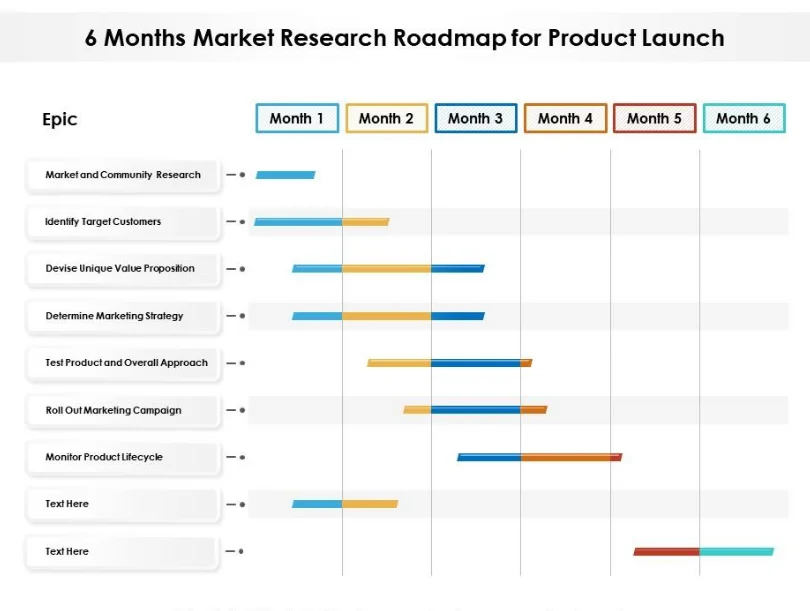
Customers’ demands change with market trends and technological advancements. That’s why your product map also needs to evolve constantly with time to reflect these changes in your product development cycle.
By designing targeted market research questions to ask the customers, you can uncover their expectations to deliver optimal product solutions.
That’s what our next case study demonstrates.
Case study – How customer research drives Twilio’s operations
Twilio, a cloud communications platform places customer discovery and research at the core of their product development strategies. It helps its teams to anticipate customer needs in a constantly changing market.
Lack of time and budget are the two biggest challenges that the company faces in its product development cycle. So, the team uses targeted market research questionnaires for a product to understand the challenges the customers face today and the ones they will face tomorrow.
With an abundance of ideas and no time to test them all, the feedback data from surveys is used to prioritize the hypotheses to run the tests. It makes the process more efficient and effective in producing positive results.
This data-backed approach is used across 18 different teams at Twilio to release new functionality every week and deliver optimal solutions to the clients.
Read the complete case study here .
To Reduce Acquisition Costs
Your customer base consists of multiple customer segments with different preferences and purchase potential. That’s why you cannot sell to everyone and need to find the right audience for your products.
If an acquired customer doesn’t bring in more revenue than it costs to acquire them, it will increase your acquisition costs over time.
We don’t want that, do we?
For example, let’s say you are targeting the entire market population using the same campaign. If your acquisition cost per customer is $300 and you acquire 20 customers from one campaign, you need to make more than $6000 to register profits.
The difficulty is you don’t know about these customers’ purchase behavior and capacity, so you cannot be sure if you will reach your goals. It adds unnecessary risks to your marketing ventures.
But, if you were targeting a specific segment with high income, regular shopping habits, or proven history of brand loyalty, You can obtain better results.
Now, the question is –
How will you separate these potential long-term customers from one-time buyers and high-value targets from other segments?
One way to do this is by building customer personas using the data from the market research survey questions. A buyer persona defines different attributes of a particular customer segment so you can hone in on the right audience to funnel your marketing efforts.
Here’s what a typical persona includes:
- Target regions
- Target demographic (age, marital status, gender)
- Ideal psychographics (hobbies, social channels, activities they indulge in, goals)
- Preferred interaction channels
- Favorite brands and products
- Total revenue till date
- Estimated lifetime value
Once you have a clearer picture of different customers, you can find high-value prospects with the potential to be long-term customers looking for product solutions that your business offers.
You can then design the correct pitch using the market research data to bring in these customers and control the overall acquisition costs.
For example:
- Plugin the demographic and psychographic data into CRM software like BIGContacts or Salesforce to convert high-value targets.
- Use your CRM to create segmented lists of prospects based on estimated value, location, current status, and more. Then target these groups individually with personalized value propositions to increase conversion rates.
- Identify their preferred mode of communication and technographic inclinations to find the right opportunities to pitch your product offering at the precise moment.
Even if acquiring and retaining such customers costs more, their overall revenue can balance the acquisition costs to deliver higher profits.
To Design Targeted Marketing Campaigns
By knowing how your target audience behaves and interacts with your business, you can find the exact opportunities to target them with personalized campaigns.
- You can use mail campaigns to target website users with app-exclusive offers to encourage them to download your app and improve app adoption.
- Add in-app broadcast messages about upcoming offers, exclusive membership benefits, and other incentives for new users to push them towards the end of the funnel.
- Create multiple landing pages to target different customer types.
- Design location-based ad campaigns with personalized value propositions based on audience preferences and problems at each location.
Case Study – How Canon’s campaigns generated 700% ROI
AWA digital was tasked by Canon, one of the biggest electronics companies worldwide, to assess and increase the demand for their products in different geographies. So, the AWA team conducted customer research using target market survey questions and discovered the following attributes about customers’ purchase behavior and reservations:
- In some regions, people were reluctant to spend money on a Canon camera as they weren’t sure if Canon was an authoritative brand.
- In other regions, authority was not as important to the users.
Using these insights, AWA optimized the ads campaigns’ messaging for different locations to include what consumers deemed important purchase factors.
The results?
With in-depth customer feedback, Canon generated an overall ROI of 700% in all regions using personalized campaigns to target the audience.
To Improve Brand Awareness
Whether you are into soft drinks or not, You probably would have heard of Coca-Cola’s 2011 Share-A-Coke ad. This single campaign put the Coke brand back on the map and reversed the 10-year steady decline in sales in the US.
Coke understood what motivates their customers and delivered a product offering that appealed to the masses to increase its brand equity- the excitement to get a Coca-Cola bottle with their name on it.
How did they do it?
In 2011, Coca-Cola rolled out its share-a-coke campaign in Australia. The company debranded the traditional Coke logo from the bottle and replaced it with the phrase “Share a Coke with” followed by a name.
The campaign used the list of the country’s most popular names (nicknames). The purpose was to make people go out and find the Coke bottle with their name on it and share it with their friends. The campaign was subsequently rolled out in 80 countries.
How did it impact Coca-Cola as a brand:
- In Australia, it’s estimated that the campaign increased Coke’s share by 4% and increased consumption among young adults by 7%.
- #ShareACoke became the top trending hashtag on Twitter globally and received over 1 billion impressions.
- In the USA, the campaign increased Coke’s market share by over 2% and brought 11% more sales compared to the previous year.
It’s not limited to big brands only.
Understanding the customers and placing your product’s value offering along with their habits, lifestyle, and behavior can help you extend your brand’s reach.
Today, there are multiple touchpoints to connect with your customers and map their journey to uncover their issues, motivations, and fears to address in your campaigns.
- Monitor brand mentions on social media and engage with the users to cultivate an online community and promote your brand.
- Reach out to satisfied customers and turn them into your brand ambassadors.
- Use targeted ad campaigns that connect people’s emotions and general behavior to imprint your brand’s image in their minds.
Quick Tips for Writing Awesome Market Research Survey Questions
With the inter-team research complete, you are ready to write your own market research questions to ask your target audience. Keep these general dos and don’ts in mind to ensure that the market survey fulfills the purpose without affecting the data quality or response rate.
Use Mutually Exclusive Response Options
If you are using response anchors with specific ranges like age group or income, check that the options do not overlap . Otherwise, it will produce an irregular data set.
Please specify your age:
In the above example, the respondent lying on either extremity of the given age ranges may get confused on which option to choose. For example, a 28-year-old respondent can choose from both second or third options.
Plus, two different respondents of the same age may select different options, which will skew your demographic data.
You can avoid this confusion by creating mutually exclusive groups as shown below:
Always Add A “Not Applicable” Or “Rather Not Say” Option
Since market research questions extract personal information, some respondents may not want to share such details with you. These include questions about age, income, gender, hobbies, social activities, and more.
Forcing such questions on the customers without allowing them to skip can irate them and lead to survey abandonment .
That’s why you can also use Qualaroo’s skip and branching logic to create smart surveys that only ask relevant questions to your respondents based on their previous answers.
Calculate the Required Sample Size
Sample size plays a vital role in your market research questions to determine the reliability of your response data.
If the response volume is low, the results may not be conclusive to point towards customers’ consensus. On the other hand, a larger sample size than required means a waste of the company’s valuable resources and time.
That’s why it’s important to calculate the required sample size to estimate the number of responses you need for your market research survey questions.
You can use any survey sample size calculator available online to get started. Just fill in the required details to get the required sample size.
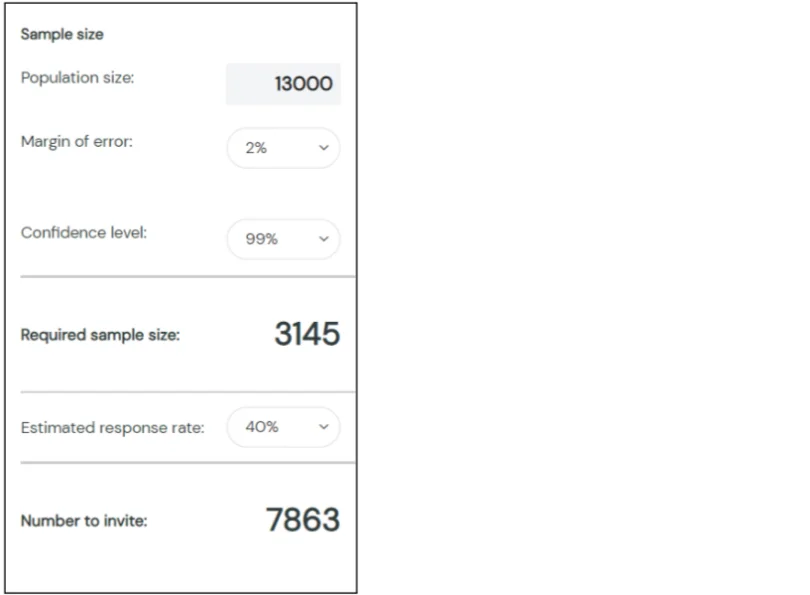
For example, to reach a statistical significance of 99%, you need at least 3145 responses to your market research questionnaire.
Consider Adding Incentives
Studies show that incentivized customer research surveys or questionnaires fetch higher response rates than general surveys.
The incentives encourage customers to invest their time in a survey and get something in return.
It means creating a gated questionnaire for market research can help you reach the required sample size quickly . The incentive can be a simple discount code, free shipping coupon, free ebook, or other freebies.
However, there is a possibility that irrelevant respondents may fill out the survey randomly just to get to the offer, which may skew the results. You can use screening questions to filter out unsuitable respondents.
Avoid Double-Barreled Market Research Questions
A double-barreled question poses two questions into one. The problem with such questions is that the respondent may have opposing views about the two statements in the questions. It makes it harder for them to choose one answer from the options .
“Please rate the [product name] on a scale of 1-10 based on overall quality and price?”
Here, the respondent may find the product quality appreciable while thinking it to be overpriced at the same time. In such a case, they may skip the question or select any option randomly.
You can easily sidestep this hurdle by breaking your double-barreled market research question into two to make it less confusing for the respondents.
Importance of Market Research
We mentioned earlier that market research questions provide important data for different operations like product development, marketing campaigns, sales pipeline, and more.
Understanding your target audience is the fundamental aspect of market research, be it a new target market or existing customers. If you know what customer research survey questions to ask your target market, you can identify different customer types’ unique traits and preferences.
AWA Digital implemented research campaigns using targeted customer research surveys to determine which add-ons were popular among the customers and why.
Steve Jobs famously said – “You’ve got to start with the customer experience and work backward to the technology. You can’t start with the technology and then try to figure out where to sell it.”
And market research helps to align your product strategies with the customer demand. Using targeted customer research survey questions, you can gauge what new features or functionality customers want to see in your products.
Image Source: Slide Team
By designing targeted market research questions to ask the customers, you can uncover their expectations to deliver optimal product solutions.
Case study – How customer research drives Twilio’s operations
Twilio, a cloud communications platform, places customer discovery and research at the core of its product development strategies. It helps its teams to anticipate customer needs in a constantly changing market.
Lack of time and budget are the two biggest challenges that the company faces in its product development cycle. So, the team uses targeted market research questionnaires for a product to understand the challenges the customers face today and the ones they will face tomorrow.
With an abundance of ideas and no time to test them all, the feedback data from customer research surveys is used to prioritize the hypotheses to run the tests. It makes the process more efficient and effective in producing positive results.
Your customer base comprises multiple customer segments with different preferences and purchase potential. That’s why you cannot sell to everyone and need to find the right audience for your products.
For example, let’s say you target the entire market using the same campaign. If your acquisition cost per customer is $300 and you acquire 20 customers from one campaign, you must make over $6000 to register profits.
But, if you were targeting a specific segment with high income, regular shopping habits, or a proven history of brand loyalty, you could obtain better results.
Now, the question is –
Image Source: brightspark
- Plug the demographic and psychographic data into CRM software like BIGContacts or Salesforce to convert high-value targets.
- Use your CRM to create segmented lists of prospects based on estimated value, location, current status, and more. Then, target these groups individually with personalized value propositions to increase conversion rates.
- Add in-app broadcast messages about upcoming offers, exclusive membership benefits, and other incentives for new users to push them toward the end of the funnel.
AWA Digital was tasked by Canon, one of the biggest electronics companies worldwide, to assess and increase the demand for their products in different geographies. So, the AWA team conducted a customer research survey using target market questions and discovered the following attributes about customers’ purchase behavior and reservations:
- In other regions, authority was not so important to the users.
Whether you are into soft drinks or not, you probably would have heard of Coca-Cola’s 2011 Share-A-Coke ad. This single campaign put the Coke brand back on the map and reversed the 10-year steady decline in sales in the US.
Coke understood what motivates its customers and delivered a product offering that appealed to the masses to increase its brand equity- the excitement to get a Coca-Cola bottle with its name on it.
- In Australia, it’s estimated that the campaign increased Coke’s share by 4% and consumption among young adults by 7%.
It’s not limited to big brands only.
Market Research: A Key to Your Business’ Success
Market research is a vital process for any business wanting to understand its customers and market better. By asking the right questions and using the right tools like Qualaroo, you can gain valuable insights that can help you improve your products or services, enhance your customer experiences, and grow your business.
In this blog, we have shared some of the best market research questions to ask your customers, as well as some of the best customer research survey templates to find market trends and industry insights. We hope that this blog has helped you learn more about market research and how to conduct it effectively.
About the author
Dwayne charrington.
Dwayne Charrington is a seasoned Product Manager with 10+ years of experience. He brings a wealth of expertise to the world of UX improvement and user research. Dwayne's also an insightful author who writes compelling pieces that assist entrepreneurs and organizations in navigating the intricate landscape of customer experience. He shares in-depth industry insights and practical tips on delivering exceptional customer experience and creating genuinely happy customers through the Qualaroo blog post.
Root out friction in every digital experience, super-charge conversion rates, and optimize digital self-service
Uncover insights from any interaction, deliver AI-powered agent coaching, and reduce cost to serve
Increase revenue and loyalty with real-time insights and recommendations delivered to teams on the ground
Know how your people feel and empower managers to improve employee engagement, productivity, and retention
Take action in the moments that matter most along the employee journey and drive bottom line growth
Whatever they’re are saying, wherever they’re saying it, know exactly what’s going on with your people
Get faster, richer insights with qual and quant tools that make powerful market research available to everyone
Run concept tests, pricing studies, prototyping + more with fast, powerful studies designed by UX research experts
Track your brand performance 24/7 and act quickly to respond to opportunities and challenges in your market
Explore the platform powering Experience Management
- Free Account
- For Digital
- For Customer Care
- For Human Resources
- For Researchers
- Financial Services
- All Industries
Popular Use Cases
- Customer Experience
- Employee Experience
- Employee Exit Interviews
- Net Promoter Score
- Voice of Customer
- Customer Success Hub
- Product Documentation
- Training & Certification
- XM Institute
- Popular Resources
- Customer Stories
Market Research
- Artificial Intelligence
- Partnerships
- Marketplace
The annual gathering of the experience leaders at the world’s iconic brands building breakthrough business results, live in Salt Lake City.
- English/AU & NZ
- Español/Europa
- Español/América Latina
- Português Brasileiro
- REQUEST DEMO
- Experience Management
- Market Research Questions
Try Qualtrics for free
Market research questions: what to ask and how.
9 min read Whether you’re looking for customer feedback, product suggestions or brand perception in the market, the right market research questions can help you get the best insights. Learn how you can use them correctly and where to begin.
What is market research?
Market research (also called marketing research) is the action or activity of gathering information about market needs and preferences. This helps companies understand their target market — how the audience feels and behaves.
For example, this could be an online questionnaire , shared by email, which has a set of questions that ask an audience about their views. For an audience of target customers, your questions may explore their reaction to a new product that can be used as feedback into the design.
Why do market research?
When you have tangible insights on the audience’s needs, you can then take steps to meet those needs and solve problems. This mitigates the risk of an experience gap – which is what your audience expects you deliver versus what you actually deliver.
In doing this work, you can gain:
- Improved purchase levels – Sales will improve if your product or service is ticking all the right buttons for your customers.
- Improved decision making – You can avoid the risk of losing capital or time by using what your research tells you and acting with insights.
- Real connection with your target market – If you’re investing in understanding your target audience, your product and service will more likely to make an impact.
- Understand new opportunities – it might be that your research indicates a new area for your product to play within, or you find potential for a new service that wasn’t considered before.
Get started with our free survey maker
Who do you ask your questions to?
Who to target in your market research is crucial to getting the right insights and data back. If you don’t have a firm idea on who your target audiences are, then here are some questions that you can ask before you begin writing your market research questions:
- Who is our customer currently and who do we want to attract in the future?
- How do they behave with your brand?
- What do they say, do and think?
- What are their pain points, needs and wants?
- Where do they live? What is the size of our market?
- Why do they use us? Why do they use other brands?
We’ve put together some questions below (Market research questions for your demographics) if you wanted to reach out to your market for this.
With the answers, you can help you segment your customer market, understand key consumer trends , create customer personas and discover the right way to target them.
Market research goals
Give yourself the right direction to work towards.There are different kinds of market research that can happen, but to choose the right market research questions, figure out your market research goals first.
Set a SMART goal that thinks about what you want to achieve and keeps you on track. SMART stands for Specific, Measurable, Attainable, Relevant and Timely. For example, a good SMART business goal would be to increase website sales for a top product by 10% over a period of 6 months.
You may need to review some strategic business information, like customer personas and historical sales data, which can give you the foundation of knowledge (the ‘baseline’) to grow from. This, combined with your business objectives, will help you form the right SMART targets tailored to your teams.
Types of market research questions
Now that you have your SMART target, you can look at which type of market research questions will help you reach your goal. They can be split into these types:
- For demographics
- For customers
- For product
Market research questions for your demographics
Demographic information about your customers is data about gender, age, ethnicity, annual income, education and marital status. It also gives key information about their shopping habits.
Here are some questions you can ask in your market research survey:
- What is your age / gender / ethnicity / marital status?
- What is the highest level of education you have achieved?
- What is your monthly income range?
- What methods of shopping do you use?
- What amount do you spend on [product/brand/shopping] each month?
- How regular do you shop for [product/brand]?
Learn more about the demographic survey questions that yield valuable insights .
Market research questions for your customer
These questions are aimed at your customer to understand the voice of the customer — the customer marketing landscape is not an one-way dialogue for engaging prospects and your customer’s feedback is needed for the development of your products or services.
- How did we do / would you rate us?
- Why did you decide to use [product or service]?
- How does that fit your needs?
- Would you recommend us to your friends?
- Would you buy from us again?
- What could we do better?
- Why did you decide to shop elsewhere?
- In your opinion, why should customers choose us?
- How would you rate our customer experience?
Learn more about why the voice of the customer matters or try running a customer experience survey.
Market research questions for your product
These questions will help you understand how your customers perceive your product, their reactions to it and whether changes need to be made in the development cycle.
- What does our [product or service] do that you like or dislike?
- What do you think about [feature or benefit]?
- How does the product help you solve your problems?
- Which of these features will be the most valuable / useful for you?
- Is our product competitive with other similar products out there? How?
- How does the product score on [cost / service / ease of use, etc.]?
- What changes will customers likely want in the future that technology can provide?
There are also a set of questions you can ask to find out if your product pricing is set at the right mark:
- Does the product value justify the price it’s marketed at?
- Is the pricing set at the right mark?
- How much would you pay for this product?
- Is this similar to what competitors are charging?
- Do you believe the price is fair?
- Do you believe the pricing is right based on the amount of usage you’d get?
Have you tried a pricing and value research survey to see how much your target customers would be willing to pay?
Market research questions for your brand
How does the impact of your products, services and experiences impact your brand’s image? You can find out using these questions:
- What do you think about our brand?
- Have you seen any reviews about us online? What do they say?
- Have you heard about our brand from friends or family? What do they say?
- How likely are you to recommend our brand to a friend?
- Have you read the testimonials on our own channels? Did they have an impact on your decision to purchase? How?
- When you think of our brand, what do you think/ feel / want?
- How did you hear about us?
- Do you feel confident you know what our brand stands for?
- Are you aware of our [channel] account?
Learn more about brand perception surveys and how to carry them out successfully.
How to use market research questions in a survey
For the best research questionnaires, tailoring your market research questions to the goal you want will help you focus the direction of the data received.
You can get started now on your own market research questionnaire, using one of our free survey templates, when you sign up to a free Qualtrics account.
Drag-and-drop interface that requires no coding is easy-to-use, and supported by our award-winning support team.
With Qualtrics, you can distribute, and analyse surveys to find customer, employee, brand, product, and marketing research insights.
More than 11,000 brands and 99 of the top 100 business schools use Qualtrics solutions because of the freedom and power it gives them.
Get started with our free survey maker tool
Related resources
Market intelligence 10 min read, marketing insights 11 min read, ethnographic research 11 min read, qualitative vs quantitative research 13 min read, qualitative research questions 11 min read, qualitative research design 12 min read, primary vs secondary research 14 min read, request demo.
Ready to learn more about Qualtrics?
68 market research questions to ask (and how to ask them)
Example market research questions, market research questions to ask customers, market research questions for product development, market research questions for brand tracking, pricing survey questions for market research, how to write your own market research questions.
No two market research projects are alike, but happily there are some tried-and-tested questions you can use for inspiration to get the consumer insights you’re looking for.
It’s all about asking questions that are most relevant to the goals of your research. Every so often the best questions are actually quite straightforward, like asking consumers where they do their grocery shopping.
If you’re creating a customer profile, you’ll ask different questions than when you’re running creative testing with your target audience, or getting insights on key consumer trends in your market.
The right market research questions are the ones that will lead you to actionable insights, and give you a competitive advantage in your target market.
Let’s kick this off and get straight into some questions, shall we?

Where do we even begin with this?! There are so many types of research and we’ll get into which questions work for each below, but here are some classic example market research questions to get you started.
These particular questions are good for surveys that you might run when you’re running some essential consumer profiling research.
- Which of these products have you purchased in the last 3 months?
- Which of the following types of >INSERT YOUR PRODUCT/SERVICE CATEGORY< do you buy at least once a month?
- Approximately, how much would you say you spend on >INSERT YOUR PRODUCT/SERVICE CATEGORY< per month?
- What is stopping you from buying more of >INSERT YOUR PRODUCT/SERVICE CATEGORY<?
- When was the last time you tried a new >INSERT YOUR PRODUCT/SERVICE CATEGORY<?
- Please rank the following on how important or unimportant they are when deciding which >INSERT PRODUCT CATEGORY< to buy?
- Which of these brands are you aware of?
- Which of these brands have you purchased from in the last 3 months?
- How do you prefer to shop for >INSERT YOUR PRODUCT/SERVICE CATEGORY<?
- Why do you prefer to shop online?
- Why do you prefer to shop in-store?
- Thinking about the following, how often do you use/listen/watch each of these media?
- Where do you go to keep up to date with the news?
- Which social media platforms do you use daily?
- What mobile phone do you currently own?
Surely you want to talk to your current customers to understand why they buy from you and what they think about your products?
Correct! But your consumer research should definitely not end with current customers!

Here’s why you should think about broadening your research to include other groups and different market research methods :
- Current customers: This is a must! Running research to your current customers will help you understand how you can make your product or service better. These are the people who’ve spent their hard-earned cash on your products so they have a unique perspective on what kind of value you offer. In addition, understanding why your existing customer base chose your brand over others can help you create messaging that resonates with people who are still on the fence.
- Previous customers: People who used to buy your products but don’t anymore can give you valuable insight into areas you might need to improve. Perhaps your brand perception has shifted making some customers buy elsewhere, or maybe your competitors offer customers better value for money than you currently do. These are the kinds of areas you can learn about by running research to previous customers.
- Non-customers: You should also ask people who haven’t bought your products why they haven’t. That way you’ll learn what you need to improve to bring new customers in. You should ideally ask the same kinds of questions, so that you can learn about what product features you need to work on but also things like the messaging you should be putting out there to win people over.
Here are some questions that are perfect for competitive market analysis research. Some of these questions might sound similar to some from our previous section on consumer profiling—that’s because there’s often some crossover between these types of research. Consumer profiling often refers to a more general type of research that covers similar ground to market analysis. If you’re wondering how to calculate market size , questions like these would be a great starting point.
- How often do you usually purchase >INSERT YOUR PRODUCT/SERVICE CATEGORY<?
- Why do you buy >INSERT YOUR PRODUCT/SERVICE CATEGORY<?
- What types of >INSERT YOUR PRODUCT/SERVICE CATEGORY< do you buy?
- How often do you buy the following types of >INSERT YOUR PRODUCT/SERVICE CATEGORY<?
- Where do you buy your >INSERT YOUR PRODUCT/SERVICE CATEGORY<?
- Where do you find out about >INSERT YOUR PRODUCT/SERVICE CATEGORY<?
- Which of these brands have your purchased in the last 12 months?
- How would you feel if you could no longer buy >INSERT YOUR PRODUCT/SERVICE CATEGORY<?
- How important or unimportant do you find the following topics? (e.g. sustainability, diversity and inclusion, ethical supply chain)
- What could be improved about the products you currently use?

By involving consumers in the product development process, you can make sure that your products are designed to meet—and ideally exceed—their needs.
Product market research can be done at several points in the product development process, by asking potential customers in your target market questions about existing products (yours or competitors’), prototypes, or just your own early-stage product ideas.
You can dive into the customer experience, specific product features or simply find out if the product quality matches the value proposition you’re putting out there.
Sometimes you even get a surprising answer to the question: how does our product or service help people?
You might learn from the survey responses that customers are using your product in a different way than you intended, opening you up to new target markets and different product types in the future.
Asking these questions also allows you to get feedback on your designs, so that you can make necessary changes before the product is released. Here’s some inspiration for when you’re conducting product market research.
There are different types of new product development research. A key type is Jobs to be done research. This research digs into the practical reasons people buy products—the jobs they need to get done with a specific product. You use these insights to help you create products that will genuinely help consumers, and that they’ll ultimately want to buy.
- How many times have you carried out [INSERT ACTIVITY] in the last 12 months?
- How much time would you typically spend on this [INSERT ACTIVITY]?
- How important or unimportant is carrying out this [INSERT ACTIVITY]?
- How satisfied or unsatisfied do you feel when carrying out this [INSERT ACTIVITY]?
- What is the best thing about carrying out [INSERT ACTIVITY]?
- How does carrying out [INSERT ACTIVITY] make you feel? Please select all that apply
- What particular problems or challenges do you run into while carrying out [INSERT ACTIVITY]?
When you’re cooking up your brand’s next product, you’ll want to go through a concept testing phase. This is where you ask consumers what they think about your idea and find out whether it’s likely to be a success. Here are some of the questions you could ask in your concept testing research.
- To what extent do you like or dislike this idea/product? [ATTACH IMAGE]
- What do you like about this idea/product?
- What do you dislike about this idea/product?
- Is easy to use
- Sounds tasty
- Is good quality
- Is Innovative
- Is different from others
- Purchase this product
- Replace the product I currently own with this
- What other products this idea/product reminds you of? Please provide as much detail as possible including the product name.
- What feature(s), if any, do you feel are missing from this product?
- How would you improve this idea/product? Be as descriptive as possible!
- What issues do you solve through the use of this product?
- When can you see yourself using this product? Please select all that apply.
- The price for this product is $25.00 per item. How likely or unlikely would you be to buy this product at this price?
Get inspired with NPD survey templates
Our in-house research experts have created New Product Development (NPD) survey templates to give you the perfect starting point for your product research!
Does the perspective of new customers change over time? How do you compare to other brands, and how do you become the preferred brand in your market and increase that market share?
Brand perception and brand awareness are super important metrics to track. These insights can be used to improve customer experience and satisfaction on a higher level than just product: the relationship you have with your customers.
This research can also help you understand how to reach the holy grail of branding: turning loyal customers into brand ambassadors.
You should also remember to ask marketing research questions about your brand to existing and potential customers.
Existing customers might have a different view after having interacted with your team and products, and you can use that to manage the expectations of your target customers down the line. And potential customers can help you understand what’s holding them back from joining your customer base.
Top tip: it’s completely fine (and super beneficial!) to run brand tracking into your competitors’ brands as well as your own. Replicating research for different brands will give you a tailored benchmark for your category and position.
Here are some key questions to ask in your brand tracking research.
- Which of the following, if any, have you purchased in the past 12 months?
- Thinking about >INSERT YOUR CATEGORY<, what brands, if any, are you aware of? Please type in all that you can think of.
- Which of these brands of facial wipes, if any, are you aware of?
- Which of these facial wipe brands, if any, have you ever purchased?
- Which of these facial wipe brands, if any, would you consider purchasing in the next 6 months?
- e.g. Innovative
- Easy to use
- Traditional
- We’d now like to ask you some specific questions about >INSERT YOUR BRAND<.
- When did you last use >INSERT YOUR BRAND<?
- What do you like most about >INSERT YOUR BRAND<?
- What do you like least about >INSERT YOUR BRAND<?
- How likely would you be to recommend >INSERT YOUR BRAND< to a friend, family or colleague?
- Why did you give that score? Include as much detail as possible
- In newspapers/magazines
- On Instagram
- On Facebook
- On the radio
- Through friends/family/colleagues
- When did you last use >INSERT MAIN COMPETITOR BRAND<?
- How likely would you be to recommend >INSERT MAIN COMPETITOR BRAND< to a friend, family or colleague?
Kick off your brand tracking with templates
Track your brand to spot—and act on!—how your brand’s perception and awareness affects how people buy. Our survey templates give you the ideal starting point!
When it comes to pricing your product, there’s no need to wing it—a pricing survey can give you the insights you need to arrive at the perfect price point.
By asking customers questions about their willingness to pay for your product, you can get a realistic sense of what price point will be most attractive to them and, not unimportant, why.
Top tip: good pricing research can be tough to get right. Asking how much people would theoretically be willing to pay for a product is very different from them actually choosing it in a shop, on a shelf next to competitors’ products, and with a whole load of other economic context that you can’t possibly test for. Price testing is useful, but should sometimes be taken with a pinch of salt.
Here are some questions you could use in your pricing research.
- Which of the following product categories have you bought in the last 12 months?
- How often do you currently purchase >INSERT YOUR CATEGORY<?
- At what price would you consider this >INSERT PRODUCT CATEGORY< to be so expensive that you would not consider buying it? (Too expensive)
- At what price would you consider this >INSERT PRODUCT CATEGORY< to be starting to get expensive, so that it is not out of the question, but you have to give some thought to buying it? (e.g. Expensive)
- At what price would you consider this >INSERT PRODUCT CATEGORY< to be a bargain—a great buy for the money? (e.g. cheap)
- At what price would you consider this >INSERT PRODUCT CATEGORY< to be priced so low that you would feel the quality couldn’t be very good? (Too cheap)
- How much do you currently pay for >INSERT PRODUCT CATEGORY<? Please type in below
- Thinking about this product, please rank the following aspects based on how much value they add, where 1 = adds the most value 10 = adds the least value.
- Thinking about the product category as a whole, please rank the following brands in order of value, where 1 is the most expensive and 10 is the least.
Formulating market research questions can be tricky. On the one hand, you want to be specific enough that you can get tangible, useful answers. But on the other hand, you don’t want to ask questions that are so difficult or unclear that respondents will get frustrated and give up halfway through.
Think about what answers you need and what actions you are hoping to take based on those answers.
We’ll help you get started with a list of steps to take when formulating your own market research questions, and putting them together in a survey that makes sense.
1. Define your research goals and link them to actions you can take
Before you can write great market research questions, you need to know what you want to learn from your research.
What are your goals? What do you want to find out? Once you have a clear understanding of your goals, you can start brainstorming questions that will help you achieve them.
2. Know your target market and the language they use
Who are you conducting market research for? It’s important to know your audience before you start writing questions, as this will help you determine the best way to phrase them.
For example, if you’re conducting market research for a new product aimed at teenagers, you’ll want to use different language than if you were conducting research for a new financial planning service aimed at retirees.
3. Keep it simple, and break things into smaller pieces
Don’t make your questions too complicated. Stick to simple, straightforward questions that can be easily understood by your target audience.
The more complex your questions are, the more likely it is that respondents will get confused and provide inaccurate answers.
If you feel a question is too difficult, see if you can break it up into smaller pieces and add follow-up questions on top.
And don’t ever load two questions into one! This falls into Consumer Research 101, but it’s amazing how often it happens. Instead of ‘What’s your favorite chocolate bar, and why?’ ask two questions: ‘What’s your favorite chocolate bar?’ and ‘Why is this your favorite chocolate bar?’
4. Be super specific
Make sure your questions are specific enough to get the information you need. Vague questions will only lead to vague answers.
For example, instead of asking ‘What do you think of this product?’, ask ‘What did you think of the taste of this product?’ or ‘What did you think of the packaging of this product?’.
5. Avoid leading questions
Leading questions are those that suggest a particular answer or course of action. For example, instead of asking ‘Do you like our new product?’, which suggests that the respondent should like the product, try asking ‘What are your thoughts on this product?
This question is neutral and allows the respondent to answer freely without feeling pressured in any particular direction. It’s also brand-neutral: people answering this question will have no idea who’s asking, and their opinion won’t be biased as a result.
6. Make sure your question is clear
It’s important that your question is clear and concise so that respondents understand exactly what they’re being asked. If there is any ambiguity in your question, respondents may interpret it in different ways and provide inaccurate answers.
Always test your questions on a few people before sending them to a larger group to make sure they understand what they’re being asked.

7. Avoid loaded words
Loaded words are those with positive or negative connotations that could influence the way respondents answer the question. For example, instead of asking ‘Do you love this product?’, which has a positive connotation, try asking ‘What are your thoughts on this product?’
This question is neutral and allows the respondent to answer freely without feeling pressured in any particular direction
8. Make sure the question is answerable
Before you include a question in your market research survey, make sure it’s actually answerable. There’s no point in asking a question if there’s no way for respondents to answer it properly. If a question isn’t answerable, either revise the question or remove it from your survey altogether.
9. Use an appropriate question type
When designing your market research survey, be sure to use an appropriate question type for each question you include. Using the wrong question type can lead to inaccurate or unusable results, so it’s important to choose wisely. Some common question types used in market research surveys include multiple choice, rating scale, and open-ended questions.
10. Pay attention to question order
The order of the questions in your survey can also impact the results you get from your research. In general, it’s best to start with more general questions and then move on to more specific ones later on in the survey. This will help ensure that respondents are properly warmed up and able to provide detailed answers by the time they reach the end of the survey.
Make smart decisions with the reliable insights
To make sure you make smart decisions that have real impact on your business, get consumer insights you can rely on. Here’s our rundown of the top market research tools.
Survey questions for market research are designed to collect information about a target market or audience. They can be used to gather data about consumer preferences, opinions, and behavior. Some common types of market research survey questions include demographic questions, behavioral questions and attitudinal questions.
There are many different types of market research questions that companies can use to gather information about consumer preferences and buying habits. They can be divided into different categories, like a competitive analysis, customer satisfaction or market trends, after which you can make them more specific and turn them into survey questions. These are some of the things your research questions can help you answer: – What is the target market for our product? – Who is our competition? – What do consumers think of our product? – How often do consumers purchase our product? – What is the typical customer profile for our product? – What motivates consumers to purchase our product?
When conducting market research, surveys are an invaluable tool for gathering insights about your target audience. But how do you write a market research questionnaire that will get you the information you need? First, determine the purpose of your survey and who your target respondents are. This will help you to write questions that are relevant and targeted. Next, craft clear and concise questions that can be easily understood. Be sure to avoid ambiguity, leading questions and loaded language. Finally, pilot your survey with a small group of people to make sure that it is effective. With these tips in mind, you can write a market research survey that will help you to gather the crucial insights you need.

Elliot Barnard
Customer Research Lead
Elliot joined Attest in 2019 and has dedicated his career to working with brands carrying out market research. At Attest Elliot takes a leading role in the Customer Research Team, to support customers as they uncover insights and new areas for growth.
Related articles
5 beverage branding ideas (with examples you can learn from), survey vs questionnaire: what’s the difference and which should you use, what does inflation mean for brands, consumer profiling, subscribe to our newsletter.
Fill in your email and we’ll drop fresh insights and events info into your inbox each week.
* I agree to receive communications from Attest. Privacy Policy .
You're now subscribed to our mailing list to receive exciting news, reports, and other updates!
- About the Authors
- Additional Materials
- Recruitment Guide Example
- Discussion Guide Example
- Qualitative Report Example
- Additional Material
- Presentation Examples
- Codes of Conduct
- Instructors Only
Practical Marketing Research
How to present the findings , unit 10 potential exam questions and answers .
1. Name six key deliverables for a marketing research project and explain why each would be useful for the client.
Answer : Any six of the following • Research plan • Questionnaire* • Sampling plan • Field plan • Field disposition reports • Tabulation plan • Raw data • Data tables* • Topline report • Final report* • Presentation* • Workshop
2. List the most common sections of a marketing research report and describe the primary function of each of them.
Answer: • Title page – provides project name and date, client name and supplier name. Could also have key contact information, copyright notice and project number. Should catch the eye and draw the client in. • Table of Contents – makes it easy to find what you are looking for • Background – provides the client’s context and reason for the research. Describes the business decisions to be made. Sets the scene for the analysis. • Research objectives – A description of the information needed to make the decisions; serves as a check list to make sure everything is covered in the analysis. • Methodology – outlines how the project was conducted and who provided the data (e.g. sample). Helps readers understand who is represented in the study. Makes it easier to replicate the research when need be. • Executive Summary – a one or two page summary of key findings, conclusions and recommendations suitable to be circulated beyond the immediate client team. • Detailed Findings – the full analysis and story-line that emerges from the analysis to guide the client in making decisions. • Conclusions and Recommendations – Overarching insights that have emerged and the recommended action that the client should take towards their business decision • Appendix – key information and proofs that were not needed to tell the main story. Added depth that might be useful for those who want more detail. • Contact information and project number – to ensure someone looking to ask a question or repeat the study months or years later can easily find the right research team.
3. a) What are the key characteristics of a good executive summary ?
Answer : It is a short summary of the key findings, conclusions and recommendations for a project, that can be circulated to others in the client organization. It is often a series of bullet points, without elaboration.
b) Why is an executive summary the most critical part of the report?
Answer : It will be read first, intensely and in many cases, nothing else will be read. It is likely what the most senior decision makers in the client organization will see.
4. List 5 key pieces of information that should appear in the Methodology section of a quantitative marketing research report.
Answer : Any 5 of the following • Nature of the research (e.g. ethnography, focus groups, online or telephone survey, etc. ) • Definition of relevant population • How the sample was selected and why • Size of the sample and expected accuracy • When the fieldwork was conducted • Where the fieldwork was conducted • Success of the fieldwork (response rate, incidence rate) • Methods used to clean / weight the data • Analytic methods used
5. Why is an appendix an important part of a marketing research report?
Answer : Helps keep the report short by removing information that is less central to the story line. Provides detail and statistics that are helpful for those who want them without cluttering the main story-telling purpose of the report. A storage area for information that might be useful in the future (e.g. secondary research). Key analytical outputs that provide credibility but are represented in a different way (e.g. infographic) in the report. Includes alternative views of the data, the questionnaire and if a short survey, perhaps the data tables.
6. Which of the following are not recommendations for formatting PowerPoint (or similar) slides for marketing research reports?
a) Use the headline to summarize what the reader needs to know b) Make the graph or chart the focal point c) Put the question wording and sample size in the appendix d) Write detailed descriptions of what the chart says in a sidebar text box e) Cut out all non-essential words f) None of the above (all are recommended) g) c and d h) a and e
7. Explain the difference between writing analysis in the active voice and the passive voice. Which approach should be used in marketing research reports?
Answer : In the active voice, the subject acts directly on the verb. For example “Teens clearly prefer the cherry flavour over all others” is written in the active voice. The passive voice implies the subject. The same sentences would read “Cherry is the flavour that was preferred”. The active voice should be used to make report findings clearer and more immediate.
8. When a graph is used to convey the analysis, which of the following is generally needed?
a. A legend or labels b. A title c. Question wording d. Base or sample size e. Numbers or a numbered scale f. All of the above g. a, b and e
9. Which of the following is not a basic principle of communications when writing a marketing research report?
a. Use plain language b. Avoid redundancies c. Use short sentences d. Avoid the passive voice e. Use an attractive format f. None, all are basic principles
10. What does ‘ chunking ’ mean in the context of writing a marketing research report?
a. Avoiding 3-dimensional graphs to provide clearer spatial relationships b. Separating complex information into smaller logical units c. Using larger, bold fonts for headlines to ensure the story is easy to follow d. Organizing analysis into related units by storyboarding e. None of the above
11. Multiple choice option: Which of the following are reasons why attention must be paid to how a marketing report looks ?
a. An attractive report is an invitation for a reader to read it. b. A badly laid out report requires more effort to read c. Key points are easier to absorb if the report is well laid out d. Readers might judge the quality of the research based on how the report looks e. An attractive report reflects well on the company and will lead to more work f. All of the above
Answer : f
Short answer option: Why is it important that attention be paid to how a marketing report looks ?
Potential Answers: • Readers often make judgements before they read one word, based on how it looks. • Anattractive report is an invitation for a reader to read it. • A badly laid out report requires more effort to read and key points may not be absorbed. • A badly laid out report is less likely to be read.
12. Should a presentation deck be different from a report deck? If so, how?
Answer : Yes, a presentation deck will have someone explaining it. It should: • be shorter (less than one slide for every 2 minutes of presentation time) • focus only on telling the main storyline • have very few words, simplified charts or infographics • be used to emphasize the point being made by the presenter, not distract from him or her • use larger font sizes so it can be seen from the back of the room (minimum 24 point) • serve as a marker to remind everyone where we are in the presentation flow.
13. Create a series of PowerPoint (or similar) slides that demonstrate the following principles of creating a visually more attractive report. Explain what you’ve done in each case.
• Create an inviting, attractive, professional deck • Use white space to ‘lighten the look’ of each page • Ensure the background doesn’t make the text hard to read • Use images only if they reinforce the message • Use an easy-to-read font • Don’t overdo emphasis like bolding or underlining • Simplify charts as much as possible.
Answer : Instructor to evaluate slides
14. Which of the following are principles behind ‘ knowing your audience ’ when presenting marketing research findings?
a. How many people will be in the room (live or virtual) b. How senior they are in the client organization c. How much they know already about the findings of the study d. Whether they are looking for the topline story or need to know details e. How much time they really have for the presentation f. All of the above g. c and d h. a, b and e
15. Explain some of the things a marketing researcher should do to improve his or her presentation style ?
Potential Answers: Any of the following; • Know your stuff • Rehearse, rehearse, rehearse • Turn your back to the screen and speak to the audience • Practice stillness • Speak clearly and accurately • Slow down • Use pauses • Look into their eyes, everyone’s eyes • Acknowledge questions • Make your point and stop
16. Why are workshops an important deliverable when completing a marketing research project?
Potential Answers: • Ensures the findings are absorbed, integrated and acted on • Gets all stakeholders onto the same path, with shared understanding and language • Leaves the client with an elevated sense of the usefulness of the research • Helps the client do an important part of his or her job • Will get you invited back to do more work
Related Books

Amazon Link
- © 2024 Practical Marketing Research
- www.practicalmarketingresearch.com

99 Market Research Questions You Should Be Asking

Asking the right market research questions at the right time can pay dividends. You wouldn’t buy a house without first researching the neighborhood – and it’s unlikely you’d take a job without doing your homework on your prospective employer. So why should starting a business be any different?
Whichever way you look at it, asking the right market research questions makes sense as a first step.
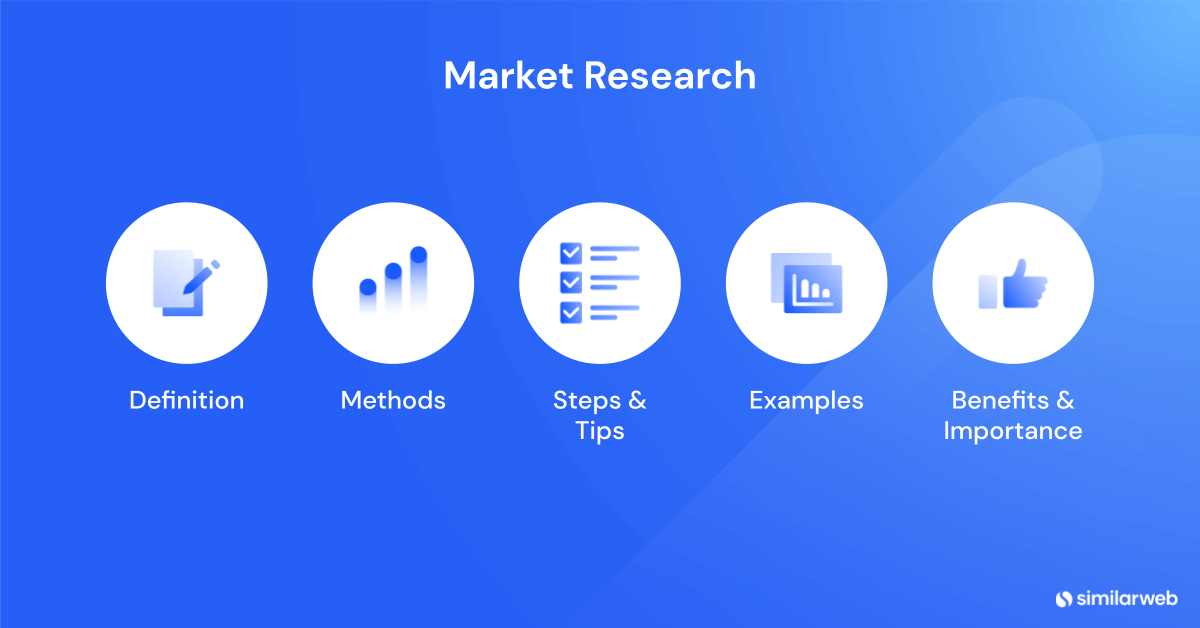
Do you want to gain a foothold in the market? Get to grips with the competition? Start thinking like your target audience? Introduce a new product or mobile app?
Whatever your goal, market research will help you understand all aspects of your industry, brand, potential customers, and rivals – good market questions can make a world of difference.
Below, we’ll walk you through 99 questions to ask for market research to succeed in the digital world. We started out as a research intelligence tool , so we know our stuff when it comes to defining a market, mapping key players, marketing strategies , and understanding trends , and target audiences.
So read on for all the questions your market research strategy needs – and how Similarweb can help you answer them.
How to choose market research questions
The market research questions you pick will depend on where your business is in its lifecycle. As we’ll get to in a moment, there are a lot of market research questions – so how exactly do you choose?
Pre-start-up – If you’ve not launched a business yet, and are just cultivating an idea – you’ll want to start with some formal market research first. Then, ask more general market research questions, and some targeted at start-ups. This will help you determine if there’s a financially viable market, whether it has blockbuster prospects, or is better off left in the cutting room.
Early start-up – If you’ve just started out, you’ll want to reach out to your target market with survey questions to help you tailor your products and services to them.
Established – If you’ve been around a little longer – and already have a few current customers – you’ll want to learn more about how you can keep improving your customer experience.
Finally, you can look at questions to ask for market research that focus on competitor analysis. These aren’t limited to any particular stage of your business’s journey. After all, getting clued up on the competitive landscape is always handy – whether you’ve just entered the market or are one of its most established players.

99 market research questions: discover, define, drill down
There’s no need to limit yourself! The best types of market research should – and do – include general questions and those addressing both existing and prospective customers. Indeed, an intelligent approach to market research should cover demographic questions all the way to those that’ll help you plan a product launch , drill down into your target market , and get the jump on your competitors.
Read on to see the best examples of market research questions in action!
Generic market research questions
These questions are most useful at the planning stage. They can apply to all businesses at any stage because markets shift, along with consumer behaviors, needs, and demands.
General market research is the process of figuring out how rich the soil is and whether the conditions are optimal to allow your business’s roots to take hold.
Some general market research questions you should be asking include:
1. How large is my product’s total addressable market (TAM)? 2. Will this market hold firm, or will it grow or decrease with time? 3. Are there already similar products or services out there? 4. If so, who’s offering them? (see the competitor analysis questions below for more) 5. Who are my buyer personas ? 6. What pain points does my product address? 7. How much market share is available for my business to take? 8. What external factors might affect the health and viability of my chosen market? 9. Which website demographics will I target? 10. Will I market my product internationally or target a specific geographical location or a single location (if so, why?) 11. Do I need to consider a website alone, or should I invest in a mobile app? (use mobile app intelligence to help to figure this one out) 12. Which suppliers or manufacturers operate in the space, and are they reputable? 13. Which marketing channels will I prioritize, and which affiliates or advertisers could I look to in order to expand my reach?
Market research questions for start-ups
Regardless of your sector, there are key things you need to establish before setting up a business. Read on to discover the fifteen market research questions all start-ups need to ask.
14. What is the total addressable market (tam), serviceable available market (sam), and share of market (som)? 15. What are the latest (and predicted) trends impacting your market? 16. Do you know who your direct and indirect competitors are?
Read through questions 71-99 for examples of market research questions to help you with this.
17. What’s your USP in the market? What’s the value-add that’ll make you stand out? 18. What do your competitors charge, and will you charge the same, more, or less?
You’ll also need to consider pricing models. For instance, pay-monthly, annual subscription, or other?
19. Do you know how much people are willing to pay for a product/service like yours? 20. Can you trial your product or service with a beta group before launch to get feedback and/or testimonials? 21. What are the most effective marketing channels for businesses like yours? 22. How active are your customers and competitors on social media? 23. How will you onboard/welcome new customers? 24. Do rivals offer new customer or loyalty discounts? 25. What kind of customer support will you offer? Look at your rival’s offerings and decide whether you want to stick with the same or do better. 26. Are potential customers driven by price, product, or service? 27. Are your competitors or market impacted by seasonal trends ? 28. What opening hours and service level agreements (SLAs) will you advertise on your site?
Market research questions for a new product
Whether established, pre-launch or newly set up, you may need to ask specific market research questions for a new product launch. Whether you simply want to test the water with an idea or concept or go a little deeper to get clearer insights, these questions will help.
29. Is there a specific pain point your product will address? (if you have already identified an ideal customer, what kinds of things do they struggle with?) 30. Is there a demand for your product in the market? 31. Are there any opportunities to partner with other companies to get referrals for your product? 32. How do you plan to market and launch your product? 33. Will you release a minimum viable product (MVP) to market first?
If you release an MVP or offer a free trial to a select group of people, you’ll need to follow this up with a survey or specific questions to get feedback around usage, benefits, and improvements. A few examples of market research questions like these could include:
34. Which feature of the product did you use the most? 35. What improvements would you like to see? 36. How much would you be willing to pay for this product? 37. Was the product easy to use? 38. Was there anything you experienced during the trial that may deter you from using our product in the future? 39. How often did you use the product? 40. Would you recommend this product to someone else? If yes, why? If no, why?
Market research questions for your target audience
Once you’re sure there’s a viable market for your business, it’s time to drill down into that market – your audience and website demographics .
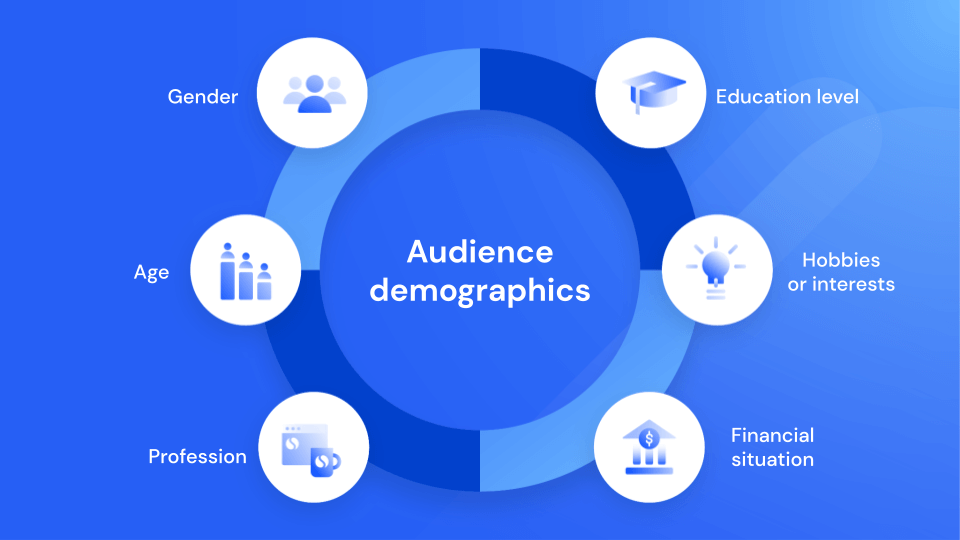
To begin, you’ll want to ask your respondents a few demographic questions to understand the basics. These might include:
41. How old are you? 42. Which gender do you identify as (if any)? 43. What’s your level of education? 44. What’s your profession? 45. What’s your household size? 46. What is your household income? 47. Which ethnic/cultural group do you identify with? 48. Where do you live? 49. Do you have any dependents? 50. What are your hobbies?
These questions provide a top-level understanding of your target audience . So, you can then utilize psychographic segmentation to dig a little deeper. These inquiries are designed to draw out your customers’ attitudes, lifestyles, likes, dislikes, motivations, and beliefs – particularly if they relate to your product or service.
The goal? To match your business with its ideal customer . Examples of these types of market research questions include:
51. Do you actively seek out new experiences or prefer to stick with what you know? 52. What do you most enjoy doing in your free time? 53. What was the last big-ticket item you purchased? 54. Have you ever boycotted a brand? If so, which brand – and why? 55. Which matters more when you make a purchase – price or quality? 56. Would you rather have more time or money? 57. How do you like to make purchases – do you prefer apps or web-based services? 58. How do you prefer to seek customer support? 59. What’s your main source of information?
For a more detailed deep dive into the above, see our guide on the what and why of market segmentation – and how to become a pro at it!
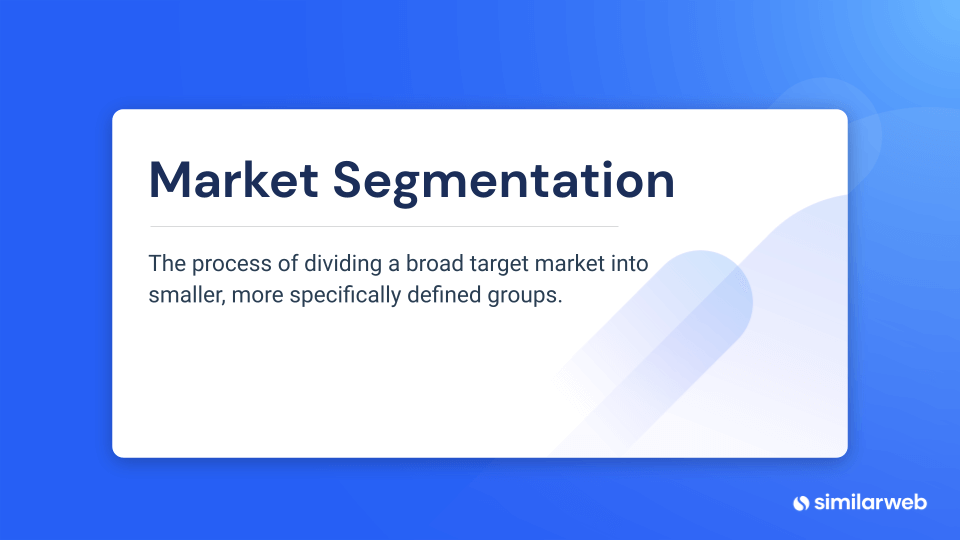
Market research questions for your customers
So, you’ve established the market for your product, nailed your target audience, and now… you’ve got customers! Congrats – that’s a surefire sign that you’re on the right track.
But simply having new customers isn’t enough. To be truly successful, you’ll need to maintain engagement , foster loyalty to your product, and keep your customers coming back for more – in other words, build your brand.
Fortunately, this is where market research can help. By asking your existing customers a few questions, you can find out what you’re doing well, what you could be doing better, and – crucially – what your brand means to them. With this knowledge, you can do more of what your customers love, and identify key areas for improvement.
Here are some of the market research questions you can ask your customers to get useful feedback:
60. How did you first hear about our brand? 61. What made you choose us? 62. How long have you been a customer? 63. How would you rate your most recent experience with us? 64. Did we answer all your questions and requests for support? 65. Would you use us again? 66. How likely are you to recommend us to a friend? 67. What do you wish our product could do? 68. Do you believe our product is priced fairly? 69. What’s the maximum you’d pay for this kind of product? 70. What do you like most about our product?
Explore our complete guide to audience development for more tips, tricks, and strategies around this type of customer analysis.
Market research questions for competitor analysis
Death, taxes, and… competition .
Yep – no matter how original or innovative your idea is, pretty soon, there’ll be hordes of wannabes targeting the same space with similar products, and guess who they’ll be targetting? Your customers.
So how do you keep your friends close and your competition even closer?
Well, a SWOT analysis is a good place to start. It involves swotting up on your business’s strengths, weaknesses, opportunities, and threats. It’s a heady mix of evaluating your business and the external factors that could affect it. So it’s naturally a great place to get your competitor analysis and benchmarking off the mark.
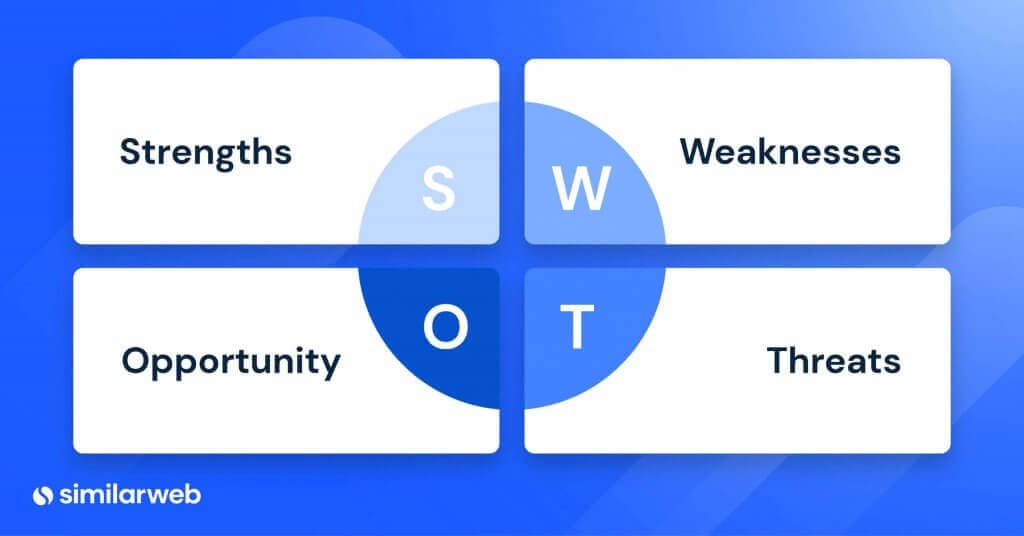
You could also begin by asking yourself the following market research questions:
71. Who are our main competitors? 72. What are they doing that we’re not? 73. What’s our unique value proposition? 74. How much web traffic do our competitors receive? 75. Do they have a mobile app? If so, is it on iOS or android? How many monthly or daily active users do they have? 76. What’s their bounce rate ? 77. Which keywords and search terms do they target? 78. Which marketing channels do they prioritize, and how frequently do they advertise? 79. How do the backlink profiles of our competitors compare to our own? 80. Are our competitors seen as more authoritative in the space? 81. What kind of content do our competitors produce? 82. How do our competitors attract customers? 83. What are the unique selling points of our competitors? 84. What do our competitors charge? 85. What social media channels do our competitors use? 86. What kind of discounts and promotions do our competitors run? 87. Which sources and affiliates drive traffic to our competitors’ sites? 88. How does our business model compare to those of our rivals?
Remember, your customers are a potential goldmine of information about your competitors . Reach out to your client base with the following market research questions:
89. Who do you seek advice from when shopping for this kind of product? 90. Are you loyal to a particular brand in the space? 91. If so, what do you love most about this brand? 92. Is there anything that this brand could do better? 93. How did you find the last product you bought in the industry? 94. Is there anything you see our competitors doing that you’d like us to do? 95. What’s most likely to make you buy a product from another brand? 98. Can you tell us the top three things that made you choose us over a competitor? 99. What one thing matters most to you when deciding between brands that offer the same product?
You may also consider including some open-ended questions so you can hear from your loyal customers in their own words. Market research surveys are a great way to uncover and collect this type of data.
If you’re unsure where to start, learn about the seven types of competitor analysis frameworks – and how to use them to get your strategy off the ground.
Similarweb Competitor Analysis Frameworks
Whether you're B2B or B2C, get started with our free and easy to use template
How to answer these questions with Similarweb
Now that you’re armed with the 99 research questions you need to succeed in your market research endeavors, how do you answer them?
Similarweb Digital Research Intelligence is a great place to start. With these tools (which you can try for free) you can effortlessly do market sizing, gauge your audience’s loyalty and engagement rate , uncover mobile app intelligence for your market, improve your site’s retention rates, and more.
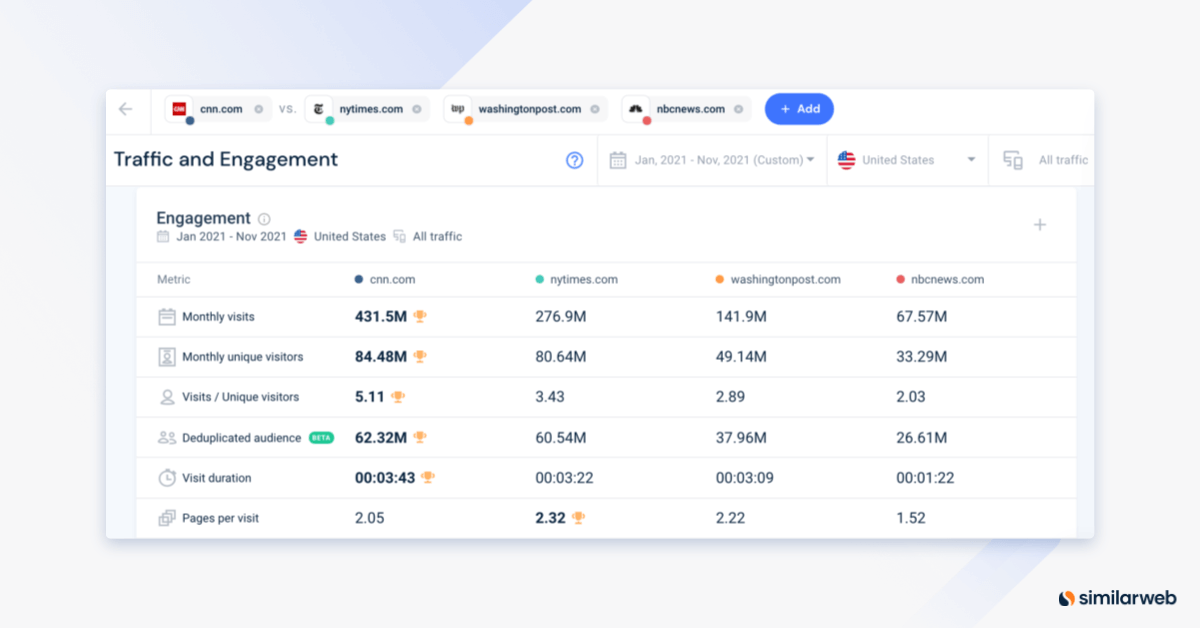
In the same vein, Similarweb can also help you conduct that all-important competitor analysis . You can build a picture of which rival sites your customers frequent and form a data-driven understanding of why.
With Similarweb Digital Research Intelligence, you get an entire suite of market research and analysis tools at your fingertips. You can monitor your industry in real time via a personalized dashboard with on-demand access to industry, company, and consumer trends. With a broad view across web and mobile app intelligence, you can clearly understand the digital landscape that matters to you ( and your customers ) most.
Don’t just take our word for it, though. Check out what Similarweb can do for you today, and start tackling those big questions now!
Level up your market research
Get the data you need to adapt to market changes and industry trends.
What is market research?
Market research assesses the viability of a product or service by reaching out to its target market. It can include primary research – such as interviews, focus groups, and questionnaires – and secondary research , like articles and white papers.
What is the best way to ask market research questions to customers?
Because they’re quick to set up, relatively low-cost, and easy to use, market research surveys are a great tool to use if you want to ask a group of people market research questions.
What’s the difference between qualitative and quantitative market research?
While qualitative data is typically mined through close observation with participants – such as in focus groups or face-to-face interviews – quantitative processes tend to involve larger-scale data grabbing. This could use forms, surveys, polls, or questionnaires to collect opinions en masse, often via emails or social media.
Qualitative data captures people’s thoughts and feelings – the prevailing sentiment around a product or service. Its quantitative counterpart, however, is more concerned with the cold, hard facts. That could be traffic metrics, engagement levels, bounce rates: anything that paints a data-driven picture!
Related Posts

How to Conduct a Social Media Competitor Analysis: 5 Quick Steps

Most Popular Messaging Apps Worldwide 2023

Market Sizing: Measuring Your TAM, SAM, and SOM
Wondering what similarweb can do for you.
Here are two ways you can get started with Similarweb today!

- Skip to main content
- Skip to primary sidebar
- Skip to footer
- QuestionPro

- Solutions Industries Gaming Automotive Sports and events Education Government Travel & Hospitality Financial Services Healthcare Cannabis Technology Use Case NPS+ Communities Audience Contactless surveys Mobile LivePolls Member Experience GDPR Positive People Science 360 Feedback Surveys
- Resources Blog eBooks Survey Templates Case Studies Training Help center
Home Market Research
20 Market Research Questions To Ask In Your Customer Survey

The primary reason you conduct any customer survey with market research questions is to make effective decisions that grow your business by selling more to both existing customers, as well as by acquiring new customers by increasing the effectiveness of your product/service to suit their needs better. But when you take even a closer look, we’re making these decisions because the main objective is to become the obvious choice for that ideal customer. For that to happen and to reach market research goals, you need to ask:
What are Market Research Questions?
Market research questions is a questionnaire that is answered by customers or potential consumers, to understand their perception and opinion on a given subject, typically pertaining to product or service feasibility, understanding consumer needs and interests, and pricing concepts.
LEARN ABOUT: Dealership Marketing Strategies & Tips
For example: A customer survey on market research of an existing product line that focuses on the usefulness of specific features in a product line. Based on the feedback received from this survey, a business can now decide which features to invest and enhance/improve, and which features to relatively defocus/discontinue. This market research , therefore, enables a business to efficiently allocate resources based on real, data-oriented insights from their own customers.
LEARN ABOUT: Test Market Demand
A similar set of market research questions can also be sent to potential consumers of a product, to understand market absorption capability.
LEARN ABOUT: Consumer Surveys
What Market Research Questions should I ask in my Customer Survey?
- Who is our ideal customer? These are typically demographic market research questions such as gender survey questions , education level, income level or location. You can expand these questions to find out your customer’s occupation or if your ideal customer is a parent, pet owner. Don’t skimp on demographics or psychographics . If anything, get really creative with them. You might consider conducting a survey with nothing but profiling questions that include where your customers shop, or where they prefer to eat. It’s critical to know as much as possible about your ideal customer so that you can begin focusing your marketing decisions around their preferences.
- What do they struggle with? Another root set of data that market researchers are searching for within their ideal customer is “what they struggle with.” What are the 5 to 7 frustrations that they are dealing with when it comes to interacting with our product or service? Suppose you are a golf accessories company and you ask your ideal customer what frustrates them about their golfing experience. In that case, you might get responses such as “expensive golf clubs getting wet during a rainstorm.” If you get enough of those responses, you may consider developing a golf accessory that protects golf clubs in the rain.
- What does your ideal customer really WANT? No matter how you phrase the market research questions (and there are countless creative formats) all we really want to know is what our customer will actually purchase as a solution. What is it that they WANT? Of course, they’re NOT going to say that they want something that doesn’t exist yet — in the 1960’s the average person would NOT have known that they wanted a microwave. They wanted hot food fast. One good way to get at these wants is to give your respondents some examples of product offerings and combinations and see how they rate them.
- What sets you apart from your competition? Competitive analysis and bench-marking are critical if you want to increase the profitability of your product and build your brand. An effective way to measure or identify differentiators or competitive advantage is to ask Customer Satisfaction questions . The key to asking these market research questions is getting the attributes right. For example “How important is it that your tires have a run-flat safety feature?” instead of asking “How important is it that your car has tires.”For example, A survey can be conducted by either Apple or Samsung to find out how satisfied are the customers with their products and what are the other features that the consumer prefers from the competitive brand. Using such data a company can incorporate features based on the demand and can also benchmark their features that the customers prefer. A Apple vs Samsung Survey Questions template can help to achieve the data required to compare their products with the competition and strategize accordingly .
- What benefits do your customers perceive? Because we all choose and purchase based on emotion — it’s important to understand specifically what emotional benefits our customers receive from our products and services. The more we connect with our customers on an emotional level and provide that benefit — the more likely they are to choose us. This is an ideal place to use matrix questions that rate the degree to which customers agree or disagree with a variety of “benefit” statements. Here is an example “I can count on Service X to pull me out of a bind.”
- Who is currently buying from us? A very important research metric to track is the “who” is currently buying a product or a service from you. Deriving a pattern from the current purchasing population, helps you target and market to a similar potential demographic. This also is an ideal place to use demographic questions extensively but it also helps if other factors like geographical metrics are tracked. You don’t want to be ignoring your existing customer base and also be smart and agile in attracting new business to your brand.
- Why are other people not buying from us? While it is imperative to know who is your potential customer or map your existing customer base, you need to find out who is not buying from you. This information is essential to understand if there are shortcomings in a product or service and at what milestone customers drop out of the purchasing process . This also helps to identify the way your business is conducted, if additional training is required to make a sale or if your product or service lacks in quality. Understanding why people are not buying from you also helps monitor if there is something fundamentally wrong with what you are offering to the masses.
- Who can buy from us in the future? It is a known fact that is about 10x more expensive to create a new customer rather than to maintain the one you currently have. That, however, is no reason not to aim for new business. It is therefore important to have a clear picture of your potential future business. Targeting potential customers, is a mix of customer demographics that have purchased from you in the past and a mix of demographics you advertise and market to. It is therefore important to have a well-rounded product or solution. For example, since your barbecue sauces and rubs are famous and widely used in the midwest does not mean they cannot be bought in the southern states.
- Why do people buy from you? What value or need does it fulfill? Customers only buy from you because of a perceived value . This value is either what you depict to potential customers or repeat customers have been privy to the value of your product or service. Customers also make a purchase because of the trust they have either in the product or service or the brand or sometimes even certain individuals. It is therefore important that you understand the value of your brand and stick to the morals and ethics of delivering high quality to ensure that the perceived and actual brand quotient is very high. The other reason why customers purchase from you is if their need is fulfilled by what you have on offer. This could either be a direct or an indirect need.
- What would make you a perfect brand? No brand can be perfect! But you can surely be close to perfect. What this means is everything about your product or service is easy to use, intuitive, is value for money, scalable and ancillary support is impeccable. All of this is obviously immaterial if the product does not solve a real problem or make life easier for the customer. Having a very high customer oriented focus gives your brand a positive ring and becomes increasingly the go-to brand. You can use a simple Net Promoter Score question to understand how referrable is your brand and who are the promoters and detractors of your brand.
- What single aspect about your brand makes it stand out and makes clients trust you? People buy from you or transact with you mostly when there is a high trust factor. Very rarely is the purchasing decision purely based on need or ease of access. To identify and build on that one factor that makes you a preferred buying choice over your competitors is very important. You can map preferred aspects of your brand to age, sex, geographical location , financial limitations etc. because each of those factors can appeal to your brand differently. It is important that you identify and fortify those aspects of your business. Your brand can also be preferred because of other factors like personnel, customer service , ethos and perception amongst peers, consumers and the society alike. Abercrombie & Fitch was a respected brand but lost a lot of market share and goodwill due to CEO’s words in one isolated incident. It takes lots of work and time to build trust but takes none to lose all of it!
- What is the best way to communicate with the kind of people you are trying to reach out to? What’s caused the downfall for a lot of brands is the inability to reach out to target customers despite their product or service being impeccable. Not knowing how to reach your target audience or potential customer makes all your hardwork go down the drain. For example, if a new life saving drug is making its way to the market, but medical professionals and doctors don’t know about it or how to administer it and its benefits, about 20 years of work goes down the drain. You need to identify the right channels and avenues to reach out to the people that will consume your product or service.
- What do customers make of your product and/or service line? There are a few brands that have one product or service and that rakes in the customers and money for them because of the nature of the product or service. But most brands aren’t this way! They would need to branch out into multiple products or services or very often, a mix of both. It is, therefore important to understand the value of your products and/or services. It is imperative to know if they solve a problem a customer has or make life easier for the customer or any other such reason. This helps in consolidating the customer base.
- What improvements could be made to your products or services to have a wider reach? A product or a service has never achieved the maximum number of customers it can get. There always is someone who could use your product or service; maybe not in the form that it currently is but there is scope to scale. This makes it so much more important to collect periodic feedback on what additions your current customer base would like to see in your brand and what can bring in new customers from your competitors. Chipping away at deadwood features and making increased usability tweaks increases the adoption and use of your product and service. For example, a retail store wants to promote the use of its self-service checkout systems. However, a lot of customers still are not opting for the system. There can be many reasons to why the customer is choosing not to use the system, like complex operation, no readability, or even slow speed of the system. To understand the reason, a Usability survey for self-service checkouts can be conducted. This will enable the store to gather first-hand information from the customers and make improvements in the system accordingly.
Learn More: User Interface Survey Template
- What is the right price to charge? Pricing a product or service is one of the most important aspects of your business. Pricing right can decide the revenue, brand perception, profitability and adoption of the product or service. Pricing too slow has a negative connotation and may increase in bringing in lower revenue. Pricing high gives the feeling of being elite and then the profitability and revenue hinge on the factors of per unit adoption rather than a very high adoption. Pricing just right is a myth – what someone finds cheap, someone else could find expensive. Where someone finds your product or service value for money, others may find it exorbitant. Hence, it is important to collect extensive feedback from your existing and potential customers about what they think is an ideal price to play. It is also important to conduct due diligence on competitors to map how they price versus the service and product features they provide. These factors will help you come close to an “ideal price” to charge.
- What is the vision for the brand? A vision for a brand dictates the level the brand aspires to be and wants to scale up to be. Apple is now a preferred phone because the vision was to be an experience, not a device. The device is the means to ensuring that vision. They wanted to make the ecosystem so robust that any device you use, that familiarity and ease of use is standardized but also stonewall easy. Despite being expensive and facing ridicule during early days due to the ecosystem being different, they are now a one trillion behemoth, more than the GDP of some countries, due to having a vision for the brand.
- What is the way to ensure you reach that vision? A vision is easy to have but tough to follow through on. This is because your vision may see many roadblocks and may not be the current flavor of the market, but it is the right thing to stick with it. Innovate in your product and service lines by taking into consideration what your customers want and need and items they themselves don’t know that they need. Despite enduring hardships, if you stick to your vision, it is easier to use that as a launchpad for being an immaculate and preferred brand.
- What should the brand branch out into to avoid stagnation or imitation? While launching a product or service, it’s essential to understand where your competitors stand on the same product type or service line. How soon can they catch up to you and imitate your service or product? On the other hand, stagnation brings the ultimate demise of a brand, product, or service line. With little innovation and competitors saturating the market by imitating your product or service line, you’ll soon see your customer base dwindle. To ensure your customers don’t drop out, the key question to ask is, “What next?”. The best way to innovate or bundle your product or service is to understand what your customers struggle with and what value they are looking for. For example, Sony is known for its PlayStations, but competitors like Xbox don’t take long to catch up to their new products. How Sony does manage to stay ahead of the market is by constantly branching into new products and services.
- What bundled service or product you can offer in conjunction with yours? Good partnerships are hard to come by, strategic ones are even harder. This question tackles two of your problems, how to offer something new to your customers and how to reduce competitors in market. Your bundled service or product though has to make sense to the use, should complement your brand and cannot be an operational and logistical nightmare for your brand which then makes it counter-productive. Facebook’s acquisition of Instagram to consolidate on social images and short content rich video, is a strategic initiative to increase customer base as well as reduce competition at the same time. The key to building strong brand partnerships is to ensure your vision and product values align. Summing up, offering a bundled service or product in partnership will not only retain the existing customer base but also attract and increase new customers.
No matter why you are conducting a survey, you’ll find these 20 research questions at the core of “WHY” you want to know. Remember, your respondents will read or spend time with absolutely ANYTHING as long as they are at the center. Be sure to keep these 20 questions in mind when creating your survey and everyone involved will save time, aggravation and money. You can use single ease questions . A single-ease question is a straightforward query that elicits a concise and uncomplicated response.
LEARN ABOUT: Marketing Insight
Beyond these 20 market research questions, here are 350+ Market Research Templates for you to use completely free!
MORE LIKE THIS

Top 17 UX Research Software for UX Design in 2024
Apr 5, 2024

Healthcare Staff Burnout: What it Is + How To Manage It
Apr 4, 2024

Top 15 Employee Retention Software in 2024

Top 10 Employee Development Software for Talent Growth
Apr 3, 2024
Other categories
- Academic Research
- Artificial Intelligence
- Assessments
- Brand Awareness
- Case Studies
- Communities
- Consumer Insights
- Customer effort score
- Customer Engagement
- Customer Experience
- Customer Loyalty
- Customer Research
- Customer Satisfaction
- Employee Benefits
- Employee Engagement
- Employee Retention
- Friday Five
- General Data Protection Regulation
- Insights Hub
- Life@QuestionPro
- Market Research
- Mobile diaries
- Mobile Surveys
- New Features
- Online Communities
- Question Types
- Questionnaire
- QuestionPro Products
- Release Notes
- Research Tools and Apps
- Revenue at Risk
- Survey Templates
- Training Tips
- Uncategorized
- Video Learning Series
- What’s Coming Up
- Workforce Intelligence
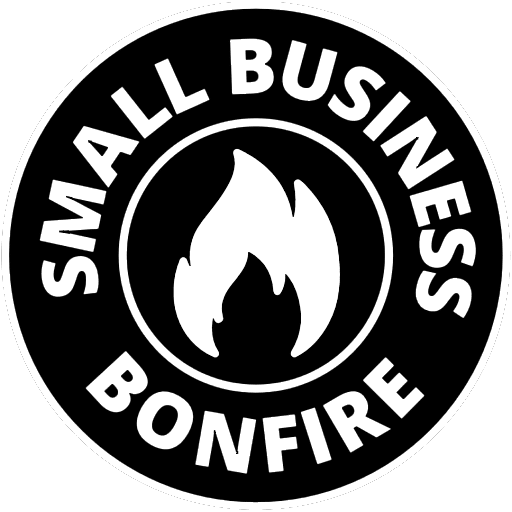
- Productivity
- Working from Home
- Social Media
- Content Marketing
- Contact SBB
75+ Market Research Questions for Success

Regarding market research, having the right questions is critical for getting accurate and valuable insights .
These 75 market research questions can help you get started on your next project, giving you an idea of what topics to cover to ensure success.
We’ll review everything you need to know about customer surveys , competitive analysis, product feedback, and more !
What is Market Research?
Market research is the process of gathering and analyzing data to understand customer behavior, market trends, and competitor strategies.
It gives businesses the insights needed to make informed decisions about their products and services.
Market research is important because it helps companies to understand what their customers want and how they can best serve them .
We’ll review the steps to help you start conducting market research and asking the right questions.
Types of Market Research
Several different types of market research questions can be used to gain insights into customer behavior and market trends.
These include the following:
- Single choice
- Multiple choice
- Ranking questions
- Likert scale
- Dichotomous

Single-Choice
These basic questions ask respondents to select one answer from a list of options.
The purpose of a single-choice question is to provide a general overview of customer preferences and needs.
An example of a single-choice question is:
“What is your favorite type of ice cream?”
Multiple-Choice
These questions ask respondents to select multiple answers from a given list of options.
They can be used to gain more detailed insights into customer preferences than single-choice questions.
An example of a multiple-choice question is the following:
Which of these activities do you do regularly?
A) Exercise
D) Watch TV
E) Listen to Music
The purpose of a multiple-choice question is to gain a more comprehensive understanding of customer behavior and preferences.
Ranking Questions
Ranking questions ask respondents to rank a list of options in order of preference.
These types of questions can be used to understand how important certain factors are when making decisions.
An example of a ranking question would be the following:
Please rank the following items from most important to least important when selecting a car:
(D) Fuel Efficiency
Likert Scale
A Likert scale is a type of question that asks respondents to indicate their level of agreement or disagreement with a statement.
It can be used to gauge customer sentiment around specific topics and gain insights into how they feel about your products or services.
An example of a Likert scale question is:
“How likely are you to recommend our product to a friend?”
Dichotomous Questions
Dichotomous questions present respondents with two possible answers and ask them to choose one. They are often used to gain quick insights into customer preferences.
An example of a dichotomous question is the following:
Do you prefer online or in-store shopping?
B) In-store
Open-ended questions allow respondents to provide more detailed answers than single-choice, multiple-choice, ranking, and dichotomous questions.
They are helpful in gaining qualitative insights into customer behavior and preferences.
An example of an open-ended question is the following:
“What do you think could be improved about our product?”
By understanding the different types of market research questions, businesses can more effectively gather data to gain insights into customer behavior and make informed decisions. With the proper market research techniques, companies can better understand their customers and identify growth opportunities.
How to Write Questions for Market Research
Writing practical questions for market research is key to getting meaningful and valuable results.
Questions should be clear and concise, avoiding jargon or overly technical language. They should also cover the topics that are most important to the project.
Additionally, it’s important to remember who you’re targeting with your questions. Write them in a way the target audience can easily understand and relate to, which will help ensure they provide accurate responses.
For example, if you are writing questions as a market research agency in the USA, you’ll want to tailor them to the appropriate culture and consumer trends.
Finally, take into account any legal or ethical considerations when writing questions. This is especially important when collecting sensitive personal data or working with vulnerable groups.
We’ll go over how to write the following types of questions:
Feedback Questions
Existing product questions, market segment quesitons, market discovery questions, brand awareness questions, customer reservation questions, pricing analysis questions.

To write feedback questions, start by asking general questions about customer satisfaction. These can include queries about the level of service they received, the quality of products, and whether they would recommend it to others.
You can also ask more specific questions, such as what features customers like or dislike, how easy it is to use a certain product or service, and what changes they would like to see.
To write great existing product questions, you need to know what customers think about your current offerings.
Ask them how satisfied they are with the features and performance of the products or if there is anything that could be improved.
You can also get their opinion on your product’s design, packaging, price point, and customer support.
These questions are designed to gain an understanding of different segments within the market.
Questions can include asking about the following:
- Income level
- Customers’ age
- Primary interests and activities
This information can help businesses identify potential target markets and tailor their products and services accordingly.
Market discovery questions help businesses explore the market and gain insights into customer behavior.
These questions can include asking customers what they currently use their product or service for, their expectations and needs, and what would make them switch to a different offering.
Brand awareness questions can help businesses understand how well their products are known in the market.
Questions can range from asking customers to rate how familiar they are with the brand to what words or phrases come to mind when they think of it.
Boosting brand awareness is important for businesses to reach new customers, so this information can be invaluable.
Customer reservation questions can help businesses identify potential barriers preventing customers from purchasing their products or services.
Questions like the following can be useful in uncovering potential areas for improvement:
- “What is holding you back from making a purchase?”
- “What would make you more likely to buy?”
- “What feature do you wish was available?”
Finally, pricing analysis questions can help businesses determine how much customers are willing to pay for their products and services.
Questions such as the following can help businesses gain valuable insights:
- “What is your budget?”
- “Would you be willing to pay more for extra features?”
- “What other products have you considered in a similar price range?”
By following these tips, you should be able to write effective questions that will provide valuable insights into the market.

75+ Market Research Questions
In addition to the above questions, here are 75 market research questions you can ask your target audience to help inform your business decisions.
- How did you learn about our product or service?
- What made you decide to purchase our product or service?
- How likely are you to recommend our product or service to a friend or colleague?
- Would you say that the features of our product or service met your expectations?
- Did you find it easy to navigate our website and locate the information needed to make your decision?
- Did you find any areas of improvement in terms of usability when using our website?
- How satisfied are you with the customer support options we provide?
- Did the delivery process for our product meet your expectations in terms of speed, accuracy, and overall experience?
- If applicable, did the installation process for our product meet your expectations in terms of speed, accuracy, and overall experience?
- Are there any other products or services we could offer that would improve your overall experience with us?
- What do you think of the quality of our current offerings?
- How would you rate the usability of our products/services?
- How would you rate the performance of our products/services?
- What could we do to make our products/services more appealing to you?
- Are there any features that are missing from our products/services?
- What do you like most about our products/services?
- What could we change to make them better?
- Do you think our prices are competitive?
- Would you recommend our products/services to someone else?
Market Segment Questions
- What age range would you classify yourself in?
- Are you married, single, or in a relationship?
- What city/town do you currently reside in?
- How many hours a day do you typically spend on the internet?
- What type of device(s) do you use to access the internet (desktop, laptop, mobile phone)?
- On average, how much money do you spend online each month?
- What products or services have you purchased online within the last 6 months?
- How likely are you to purchase goods or services from an unfamiliar website compared to a familiar website?
- How often do you interact with social media platforms such as Facebook and Twitter?
- Are there any particular features or functions that would make it easier for you to shop online or make purchases?
- Do you find yourself comparing prices and product features before making a purchase decision?
- Are there any particular brands that stand out to you when shopping for products or services online?
- When looking for information about products and services online, what sources do you rely on most (e-commerce websites, review sites, etc.)?
- What types of discounts are most enticing to customers when making an online purchase (free shipping offers, bonus items with purchase, coupon codes)?
- Do certain payment methods influence your purchasing decisions?
- What do you think are the most important features when considering a purchase?
- How would you define your personal style and aesthetic preferences?
- Are there any new products or services you want to see in the marketplace?
- Do certain brand values affect your purchasing decisions (e.g., sustainability, ethical practices, etc.)?
- What do you think are the biggest challenges facing companies in your industry?
- When researching products or services, what content or information would you like to see from brands?
- Are there any particular technologies that you think could improve customer experiences online?
- Do current trends in social media affect your views on certain brands and their offerings?
- Are there any new products or services that would benefit your lifestyle?
- What do you think sets certain brands apart from their competitors?
- Are there any particular marketing strategies that you find appealing when considering a purchase?
- Which channels do you prefer to use for customer service (live chat, email, phone)?
- What is your familiarity with our brand?
- Do you recognize our brand name when shopping online or in-store?
- Are there any particular elements that stand out to you in the design of our website, logo, products, and services?
- How do you feel when interacting with our brand (positive, neutral, negative)?
- What do you think our brand stands for?
- What words would you use to describe our brand and its offerings?
- Do you prefer more traditional or modern marketing techniques/strategies when engaging with our brand?
- Which social media platforms do you associate most with our brand?
- Are there any particular campaigns that have resonated with you in the past?
- What type of content do you expect to see from our brand?
- Are there any particular features or services that make our brand stand out from its competitors?
- Do certain events or promotions influence your views on our brand?
- Do you believe our brand offers competitive pricing compared to other brands?
- Do you think our brand is transparent with its customers regarding providing information and responding to inquiries?
- Are there any particular resources that could help customers better understand our brand and offerings?
- What do you believe our brand should focus on to improve customer experiences?
- Do you think our brand adequately addresses customer feedback or suggestions?
- Do certain rewards or loyalty programs influence your purchasing decisions when considering our brand?
- Do you feel that our brand keeps up with the latest trends in technology and innovation?
Customer Retention Questions
- What do you believe are the key factors that make customers commit to our brand?
- Do you think our customer service is up to par with competitors in the market?
- How likely are you to recommend our products or services to friends and family?
- What do you think keeps customers engaged with our brand, both online and in-store?
- Are there any particular features or services that you think make our brand stand out from its competitors?
- Do certain discounts, promotions, or loyalty programs influence your decision to stay with us?
- What do you think is the biggest challenge when retaining customers for our brand?
- Are there any new products or services that would make you a more loyal customer?
- Are there any particular communications or marketing tactics that could help keep customers engaged with our brand?
- Do certain events or milestones influence your commitment to our brand?
- What do you think is the most effective way to show appreciation for customers?
- Are there any loyalty or rewards programs that have successfully kept customers loyal to our brand?
- Do you think our customer service team is responsive and attentive when addressing customer needs and inquiries?
- Are there any particular features or services that could improve your overall experience with our brand?
- Do you feel our prices are reasonable compared to other products and services in the market?
- Are there any specific features or services that add value to our offerings?
- What do you think is the best way to differentiate ourselves from competitors regarding pricing?
- Are there any particular discounts or promotions that could influence customers to purchase from us?
- Do you think our pricing strategy is transparent and easy for customers to understand?
- Do certain market events or trends influence customer decisions when choosing our brand over competitors?
- What do you believe are the biggest challenges when it comes to setting prices for our products or services?
- Do you think our price points are competitive enough to draw customer interest?
- Are there any particular features or services that could be offered at a lower cost than competitors?
- Do you think certain rewards or loyalty programs influence customer decisions when comparing brand prices?
- Are there any discounts, promotions, or offers that have successfully driven sales?
- What is the most effective way to communicate pricing information to customers?
- Are there any particular resources or tools that could be used to analyze and adjust our prices as needed?
Market Research Wrap Up
These 75 market research questions provide a great starting point for any business looking to gain valuable insights into customer behavior and market trends.
By using this as a guide, you can ensure that your surveys are comprehensive and effective in helping you make informed decisions about your products and services. Good luck!
Do you have any questions of your own to add? Let us know in the comments below!
Newsletter Signup
Join The Leads Field Guide Newsletter for tips, strategies and (free) resources for growing your leads, and closing more deals.
Related Articles
Beyond press releases: the evolving role of public relations agencies, how to build a business website (2023), how to get a small business loan: 5 steps for smbs.
Toll Free : 1 800 371 6224 | US : +1 650 204 3191 | UK : +44 8082 803 175 | AU : +61 1800 247 724 | Philippine Local No : 63-2-83966000
- 24 7 Answering Service
- Virtual Receptionist Service
- Phone Answering Service
- Customer Support Outsourcing
- Outsourced Technical Support
- Omnichannel Contact Center
- Multilingual Call Center Services
- Telemarketing Services
- Lead Generation Services
- Appointment Setting Services
- Cold Calling Services
- Outsource Telesales
- Market Research Services
- Survey Processing Services
- Accounts Receivable Services
- Accounts Payable Services
- Back Office Services
- Call Center Outsourcing Services
- Certificate Intelligent Document Processing
- Community Moderation Services
- Data Management Services
- Debt Collection Services
- Loan Processing Call Center
- Outsource Form Processing Services
- Recruitment Process Outsourcing
- Staff Leasing Services
- Virtual Assistant Services
- Healthcare BPO Support Services
- Legal Outsourcing Services
- BPO Real Estate Services
- Insurance BPO Services
- Retail Outsourcing Services
- eCommerce Outsourcing Service
- Mobile App Customer Support
- HR Outsourcing Services
- 3D Rendering Services
- Travel Outsourcing Services
- Telecom BPO Services
- Education Process Outsourcing
- eServices Call Center
- Sample Recordings
- Message From The CEO
- Management Team

- 24 / 7 Answering Service
- eCommerce Outsourcing Services

Benefits of Sales Team Outsourcing Every Business Must Know

Data Entry Services for SMEs
Home | Blog | 79 Market Research Questions For Better Results
79 Market Research Questions For Better Results
By Magellan Solutions
Updated on August 4, 2023

Valuable answers come from practical questions.
In this article, you’ll learn about the top market research questions you can ask to obtain valuable insights from your potential and existing market.
What you’ll learn:
What is market research, how to write market research questions, examples of market research questions.
- For new businesses
- For a new product
- For existing customers
- For potential customers
- For competitive analysis
- For customer service improvement
Market research is the systematic process of getting and analyzing feedback from different market segments. Using this approach, you can identify the potential of your product or service when offered to a specific consumer demographic.
In other words, it helps you find the right customers to patronize your business. It also enables you to determine the pain points of your target market. Through this, you can develop or improve products or services that can resolve the struggles of your existing customers or target audience.
It has three main methods:
- Online survey – This tool can gather information from a sample population online. To help you get started, check out some of the methods for conducting surveys: – If you are starting a business, you can begin by utilizing email and social media to send survey questions or polls to your target market.- You can also embed it into your website or app, but since it is a reactive method, the chances of getting feedback are lower.- If you think you have the budget for it, you can send it to paid survey sites to get higher response rates.
- Phone interview – Have you experienced receiving cold calls from certain companies asking about your opinion on a particular product or service? If yes, then you’re probably familiar with market research. A phone interview is a proactive way of conducting market research surveys. It guarantees you a faster and more accurate response from your target demographics. Some companies outsource to a survey call center to expand their reach while saving time and money.
- Face-to-face interviews – This is the traditional way of conducting customer surveys. It is one of the best ways to get actual, first-hand opinions. Unlike the first two methods, it requires you to go out to the street and into the houses of your sample respondents. Here, you can encourage consumers to participate by giving freebies or samplers. While this is an excellent way to build personal relationships with your ideal customers, it is not as efficient as phone interviews and online surveys.
Aside from gathering first-hand consumer data, you can also keep track of economic trends .
Secondary information provided by existing sources enables you to kick-start your market research. It gives general and quantifiable data on industry trends, demographics, and potential competitors.
Some of the best secondary information sources include government census data, statistics and research reports published by independent market research firms, and business news.
It’s easy to think of and write questions right off the bat. But first, make sure you’re square on the following details:
- What is the problem you want to solve?
- What are your goals/objectives?
- Who is your target audience?
From there, you can start brainstorming questions that would provide insightful information for your marketing, sales, and research and development departments.
Here are some things you can consider that will add depth and dimension to your market research process:
- Demand is the number of products consumers are willing to purchase at any given time.
- Market size – the number of potential consumers within a specific market.
- Customer demographics – any given sector of a population segmented using different factors such as age, gender, occupation, income, location, etc.
- Location – the place where the target market resides.
- Market saturation – the number of similar products available to target customers.
- Economic indicators – any economic activity in the location of your business that is presented in metric format.
- Pricing – the cost of products or services based on target consumers’ economic status and competitors’ current pricing.
Once you’ve listed enough questions based on some of these elements, the next step is to select questions that bring you closer to your objectives. Make sure to remove those that won’t give enough value.
While answering those questions, create a clear picture or a registry of the possible target audience response. Ask only what is necessary to prevent your respondents from getting bored. Remember that if it takes too long, they might get triggered to answer questions hastily.
Also, keep your market research process simple. Through this, you will not only keep the attention of your respondents, but it will also enable you to obtain valuable answers.
Do you still find yourself struggling to come up with appropriate market research questions? If yes, check out these examples and carefully select what you need.
Market research questions for new businesses
If you’re opening a new business, it pays to gather extensive information about the industry, market size, target audience’s buying behaviors, competitors, and competitive advantage.
- Who are your target customers?
- What are the core problems of your customers?
- What is your product or service?
- How can your product or service solve the problems of your customers?
- Does your product fit into the current market?
- Is it possible to create a new market for your product?
- What is the current market size? What is the potential size of the market?
- Will the market size grow or contract? Why?
- What are the buying habits in the market? How can we exploit them?
- What are the existing segments of the market?
- In which segments do you plan to compete?
- Which of the segments are growing, and which are contracting?
- Who are your direct competitors? What are their strategies for attracting customers?
- What is your competitive advantage?
- Where do you plan to establish your business?
- What is the current economic status of your target customers from that location?
- How much do you plan to charge your customers for availing of your products or services?
- How much are you going to spend on customer acquisition?
When starting a new business, position yourself as an expert. This means having in-depth knowledge about your customers, the industry, the market trends, and competitors.
It is essential to curate questions that can show you opportunities to succeed. Assess your edge over your competitors. For example, you can ask your target market how your competitors can improve their products or services. Once you’ve analyzed their answers, it will be easier to figure out what you can add or enhance to meet customer expectations.
Market research questions for new product launch
Expanding your product line also requires lots of research and market testing. Here are some of the questions you can ask.
- How do you plan to test your new product?
- What will you test? (Product, marketing collaterals, marketing message, etc.)
- Where will you find users who will test the product?
- How high is the current demand for your new product?
- How are you going to promote it?
- What channels are you going to use?
- Where do you plan to promote it?
- Who will be your market?
- How much do your competitors charge for a similar product?
Before launching a new product, you must know your target customers, the demand for the product, your marketing or advertising strategy, and your possible competitors.
Questions to ask existing customers
When researching existing customers, the main goal is to find out how they feel about your brand. Since they have first-hand experience using your products, they are the ones who can show you their strengths and weaknesses.
You can use a rating scale or a checklist for these questions. This way, it will be easier for your customers to answer your survey.
Checklist with ‘other’ option in case the answer isn’t indicated on your survey form:
- How did you hear about us?
- How long have you been our customer?
- What problem does our product solve for you?
- What features do you like most about our product?
- What do you like the least about our product?
- What made you choose us over the other products in the market?
- How often do you purchase our product?
- Would you avail of our product/service again?
- What else can we do to improve your experience with our brand?
Rating scale
- How well does our product meet your needs?
- How would you rate your last experience with us?
- How likely are you to recommend our product to a friend?
- How will you rate the speed and promptness of our customer service team?
The goal of conducting market research among your existing customers is to know their satisfaction with your brand. This will let you see what you need to continue doing and the areas you need to improve.
Market research questions to ask potential customers
When interviewing your potential customers, get enough information about their demographics, socioeconomic status, and unique interests.
These are the essential information you need to acquire:
- Address (doesn’t need to be specific, especially if confidentiality is required)
- Education level
- Profession/Job
- Household income
- Household size
On the other hand, these are some questions you can ask to help you better segment your target audience:
- What are your hobbies and interests?
- What are the common challenges you encounter regularly?
- What are your main goals?
- What products do you consider the most important for your everyday life?
- Where do you usually discover new products?
- How much do you spend when purchasing (specify here the type of product you’re offering)?
- How often do you buy (again, specify here the type of product you’re offering)?
- How likely are you going to buy our product?
You can also add more questions about your brand to get the necessary information when improving your marketing message.
These questions will help your marketing team create value-added promotional materials that appeal to your target audience.
Questions for competitive analysis
Competitive benchmarking lets you compare your performance against your direct competitors. Here are some questions to help you get started:
- How’s your brand’s performance compared to your competitors?
- How do your competitors advertise or market their products?
- What are the other brands’ customer acquisition strategies?
- How much web traffic does your competitor receive?
- What keywords are your competitors using?
- What type of content are they producing?
- Are you using the same keyword on your website?
- What other channels do your competitors use aside from their websites?
- How many inbound links do your competitors have?
- How active are the other brands in producing backlinks with authority websites?
Measure your success by knowing the performance of your competitors. Analyzing their products, services, marketing strategies, sales, authority in the industry, customer acquisition strategies, and branding will let you see where you can thrive better than your competitors.
To improve customer service
Customer service is a crucial element in customer retention. It serves as the fine line between repeat business and an abandoned transaction. Do it right , and your customers will come back for more. Neglect it, and your customers are likely to move to your competitors.
Always check the quality of customer service you provide to keep your loyal customers.
- How fast do you respond to inquiries?
- How well and quickly do you resolve customer complaints?
- What are your customer satisfaction ratings?
- What problems do your customers often experience concerning your customer service?
- How can you improve your customer service?
- How can you measure your customer experience?
- Do your customers know all of the features, products, and services your business offers?
- Do you provide a personalized experience?
- How convenient is it to reach your business?
- What customer service channels are you using?
- Is your website or mobile app user-friendly?
- Is the experience consistent across all channels?
- Does your brand appear trustworthy based on online reviews?
- If you have international clients, do you provide multilingual options ?
As high as 49% of US customers leave a brand due to poor customer service. Don’t let this happen to your brand! Regularly assess the quality of your customer service to provide positive customer experiences.
In conclusion
Market research can save a lot of trouble and financial heartbreaks when done right. Whether starting a business, chasing growth, creating better marketing messages, or improving your processes, market research can bring you the answers you need to develop dynamic strategies. Ask the right questions, and you’ll surely get valuable results.
Do you need the help of a market research call center to reach a wider audience within a shorter time? Magellan Solutions is here to help! We offer tailor-fit solutions to meet the needs and budget of your business. If you want to know more, contact us using the form below.
TALK TO US!
Contact us today for more information.
You can also contact our numbers: Toll Free: 1 800 371 6224 US: +1 650 204 3191 UK: +44 8082 803 175 , AU: +61 1800 247 724
Share this:
Want to know more?
Explore our services further by filling out the form below, and we'll reach out to you soon!
Give us a call!
1 800 371 6224
United States:
+1 650 204 3191
United Kingdom:
+44 8082 803 175
+61 1800 247 724
Philippines:
63-2-83966000
Magellan Solutions
Related Articles

A Quick Guide to Direct Marketing Inbound Teleservices

Risky Pay Per Sale Telemarketing: What’s the Alternative?

Performance Based Appointment Setting – Does It Work?

Join Magellan and Make a Difference!
Privacy Overview

Get a 60 Minute Assessment
Claim your free 60-minute assessment with our outsourcing expert today and discover how you can save time and money while growing your business!
Business Research Guide
- Journal Articles & News
- Company & Financial Information
- Industry & Market Information
- Country Information
- Case Studies
- Business Plans
- Data & Statistics
- Find more Business Research Materials
- Books and Ebooks
- Business News
- Useful Web Sites
- Research Tips & Tools
Subject Guide

My job is to help you with your research. Email me with your question or to make an appointment for a personal consultation in-person or via Zoom.
Welcome to the Business Research Guide!

Use this research guide to locate authoritative resources for business-related subjects, such as entrepreneurship, innovation, marketing, information technologies & systems, international business, management, and more.
This is also a good starting point for students who are taking ENGL 100WB and LLD 100WB. You may want to search the Occupational Outlook Handbook to look up a profession you're interested in. This Bureau of Labor Statistics publication provides information on overall work environment, salaries, job outlooks, and more.
Getting Started with Library Research
- Library Accounts Access to various library accounts, including OneSearch, Interlibrary Loan, SJPL. Materials not available from the joint King Library can be requested from other libraries through Interlibrary Loan.
- Access Databases from off Campus Enter your SJSUOne Account details to access resources off-campus. Call 408-808-2470 if you need technical assistance. Access all e-resources, including almost 400+ databases, thousands of journals and 100,000+ ebooks, etc. using your SJSUOne Account details.
- Student Computing & Technology Services You can check out a laptop, iBook, iPad or tablets for up to one week from the Student Computing Services. If you need help using Adobe, iMovie, Microsoft Office (Excel, Power Point, Word), or SPSS and other software applications, go to Student Technology Center for assistance. Both are on the 4th floor.
- Finding Your Book on the Shelf This tutorial provides a quick introduction to call numbers.
- Find Books and Articles with OneSearch Use OneSearch to find the books and articles you need.
- Paraphrasing
- Next: Journal Articles & News >>
- Last Updated: Feb 16, 2024 10:43 AM
- URL: https://libguides.sjsu.edu/business
METRICLAB | Relentless research and innovation
Relentless research and innovation triangle
Metric lab delivers vital insights that drive intelligent product decisions through an obsessive focus on the customer., we identify market opportunities.
Disruptive innovation solves problems that millions of people encounter on a regular basis. Metric Lab combines UX and market research strategies to deeply understand market segments, identify problems and needs, and isolate marketing and sales channels to assist with product placement.
We deliver Data that tells a Story
Raw data is confusing, ambiguous, and unhelpful. For data to tell its story, it has to be collected with a structured methodology and analyzed and interpreted with discipline. Metric Lab specializes in interpreting that data, uncovering the story, and transmitting knowledge to product teams in order to help them optimize their design and development decisions.
We identify behavioral trends
Our insights are focused on people, their stories, and deeply understanding how they live. We study human behavior, analyze markets and identify behavioral trends.
Featured in

IMAGES
VIDEO
COMMENTS
Marketing Research Question Bank. by Admin. Given below is the Marketing Research Question Bank useful for MBA, MMS, BBA, PGDM and other management students. This is also useful for exam preparation of subjects like Contemporary Marketing Research. Hope this set of MR important questions will help you score better in the university examination.
Marketing Research Chapter 1: Introduction to Marketing Research I. MCQ: _____ is undertaken to help identify problems that are not necessarily apparent on the surface and yet exist or are likely to arise in the future. A) Problem Identification Research B) Segmentation Research C) Problem Solving Research D) Product Research
Marketing Research Chapter 3: Research Design, Secondary and Syndicated Data I. MCQ: _____ is research conducted to define the problem and identify possible courses of action: A) Exploratory research B) Conclusive research C) Descriptive research D) Causal research E) Directed research Large, representative samples are often used in _____: A) Conclusive research B) Subjective research C ...
Marketing Research: An Applied Orientation, 7e (Malhotra) Chapter 2 Defining the Marketing Research Problem and Developing an Approach. 1) Problem definition is the most important step in the ...
Likert scale market research questions can help you measure the extent of respondents' agreement/disagreement with the given statement. The answer options are arranged from positive to negative sentiments or vice-versa, with the neutral option in the middle. There are two types of Likert scales: 5-point and 7-point.
Marketing Research Question Bank - Free download as Word Doc (.doc), PDF File (.pdf), Text File (.txt) or read online for free. The document contains 30 marketing research questions covering a variety of topics including market segmentation, demand forecasting, cluster analysis, conjoint analysis, chi-square tests, data processing, qualitative research methods, levels of measurement, and ...
Market research (also called marketing research) is the action or activity of gathering information about market needs and preferences. This helps companies understand their target market — how the audience feels and behaves. For example, this could be an online questionnaire, shared by email, which has a set of questions that ask an audience ...
Survey questions for market research are designed to collect information about a target market or audience. They can be used to gather data about consumer preferences, opinions, and behavior. Some common types of market research survey questions include demographic questions, behavioral questions and attitudinal questions. 2.
Unit 10 Potential Exam Questions and Answers. 1. Name six key deliverables for a marketing research project and explain why each would be useful for the client. 2. List the most common sections of a marketing research report and describe the primary function of each of them. • Title page - provides project name and date, client name and ...
Research questions. A (n) _______ is a conceptual scheme based on foundation statements, which are assumed to be true. Theory. An unproven statement or proposition about a factor or phenomenon that is of interest to the researcher is called a (n) hypothesis.
Here, I've detailed 23 use cases and curated 98 quantitative market research questions with examples - making this a post you should add to your bookmark list , so you can quickly refer back. I've formatted this post to show you 10-15 questions for each use case. At the end of each section, I also share a quicker way to get similar ...
99 market research questions: discover, define, drill down. There's no need to limit yourself! The best types of market research should - and do - include general questions and those addressing both existing and prospective customers. Indeed, an intelligent approach to market research should cover demographic questions all the way to those that'll help you plan a product launch, drill ...
Here are 7 market research survey questions every marketer should ask: 1. Who is currently purchasing your products or services? A very important question to ask, to understand your customer's or client's purchasing buying behavior and understand what exactly are their needs and preferences. Once you can identify their purchase pattern and ...
A single-ease question is a straightforward query that elicits a concise and uncomplicated response. Beyond these 20 market research questions, here are 350+ Market Research Templates for you to use completely free! Market research questions is a questionnaire that is answered by customers or potential consumers.
An example of a multiple-choice question is the following: Which of these activities do you do regularly? A) Exercise. B) Read. C) Cook. D) Watch TV. E) Listen to Music. The purpose of a multiple-choice question is to gain a more comprehensive understanding of customer behavior and preferences.
Here are some things you can consider that will add depth and dimension to your market research process: Demand is the number of products consumers are willing to purchase at any given time. Market size - the number of potential consumers within a specific market. Location - the place where the target market resides.
Identify your research problem. 2. Review existing literature. 3. Define your research objective. 4. Write your research question. 5. Refine your research question.
Marketing Research Question Bank - Free download as Word Doc (.doc / .docx), PDF File (.pdf), Text File (.txt) or read online for free. Describe the process of marketing research with the help of the various steps involved in it. Describe the different types of research, clearly pointing out the differences between an experiment and a survey.
Question Paper Code : BS2164. 2 BS2164 12. (a) Explain the various steps involved in marketing research process. ... (13) Or (b) What kind of marketing research techniques is practiced before introducing a new product into the market? (13) 13. (a) Explain different methods of data collection and the components of data analysis and interpreting.
Welcome to the Business Research Guide! Use this research guide to locate authoritative resources for business-related subjects, such as entrepreneurship, innovation, marketing, information technologies & systems, international business, management, and more. This is also a good starting point for students who are taking ENGL 100WB and LLD 100WB.
of research for better understanding of this book. There are two parts of the book. Part 1 (chapter 1-4) consists of steps for developing research proposal and part II (chapter 5-10) explains how to develop a research proposal or write a research report. A summary is given at the end of every chapter that helps the reader to recapitulate the ideas.
Metric Lab combines UX and market research strategies to deeply understand market segments, identify problems and needs, and isolate marketing and sales channels to assist with product placement. We deliver Data that tells a Story. Raw data is confusing, ambiguous, and unhelpful. For data to tell its story, it has to be collected with a ...
Silicon Valley Bank (SVB) is a U.S,-based commercial bank with clients ranging from fina ncial. services to technology and life science companies, venture capital, and priva te equity firms. SVB ...